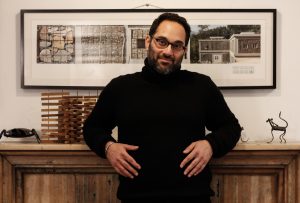ArchitectureLive! is hiring for various roles, starting from senior editors, content writers, research associates, graphic designer and more..

Menu
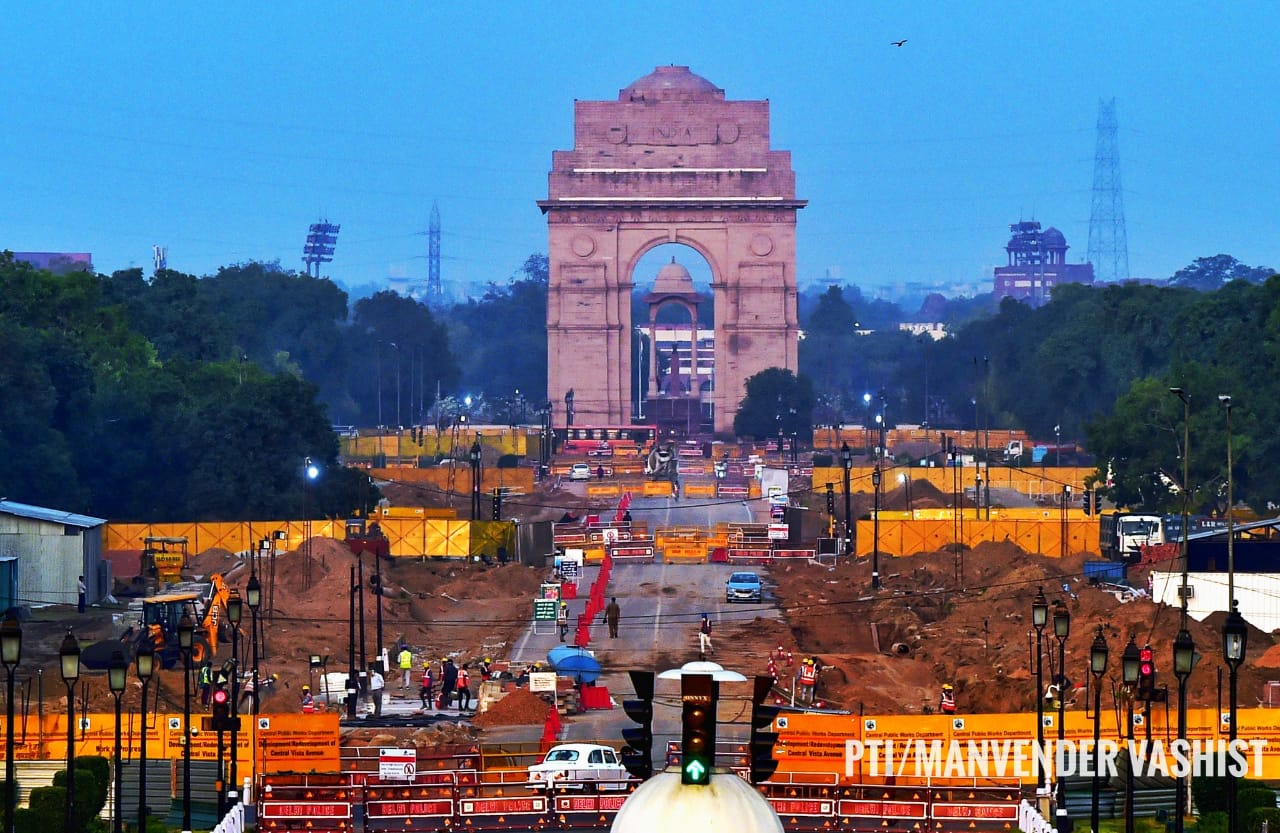
Introduction
(2,240 words, 9 minute read)
As a nation we are about to embark on democratic India’s most symbolic project – the re-development of New Delhi’s central vista.
The central vista and it’s precinct is approximately three kilometres long and stretches from Rashtrapati Bhawan on the west to India Gate on the east. The redevelopment of this tract of land and other land parcels adjoining it will cost the exchequer upwards of Rs. 20,000 crore and is being undertaken to commemorate in 2022, 75 years of India’s Independence. Other objectives of the project include increasing the productivity and efficiency of the government, expanding and improving the quality of public space that falls within its immediate precinct, modernizing the parliament, providing “adequate facilities for the Vice President and the Prime Minister, refurbishing and better equipping the central vista, strengthening cultural and recreational facilities in the central vista and commemorating 75 years of India’s Independence”.2
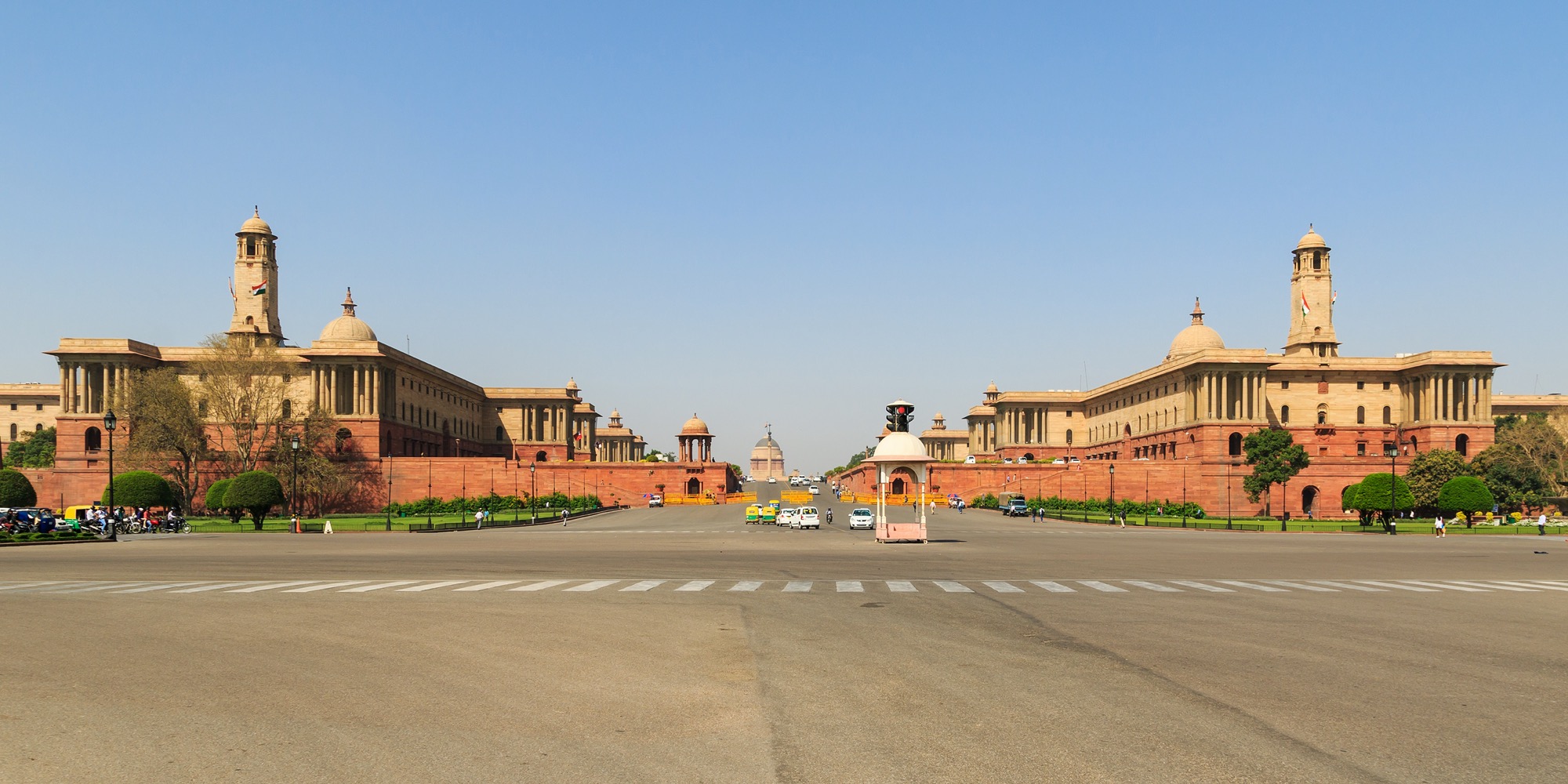
RASHTRAPATHI BHAWAN, NORTH AND SOUTH BLOCK
“The Re-Imagining and Renewing of a National Icon”, as the architect Bimal Patel of HCP Design, Planning and Management Pvt. Ltd. titled a recent presentation of the project (June 13, 2020) is perhaps long overdue.3 Edwin Lutyens and Herbert Baker were the architects of the central vista and of key buildings such as the Rashtrapathi Bhawan (the erstwhile Vicerorys House), the two secretariats, North and South Block, the Parliament (Council Chambers) and the National Archives along with other projects within the new city. They were assisted in the New Delhi project by both other architects and contractors but as the name Lutyens Delhi suggests it was their contribution or perhaps more accurately Edwin Lutyens contribution that was to be defining. As the seat of government and the symbolic centre our democracy, a re-development project especially one that proposes to reimagine a national icon would be of great interest to a number of people.
But you who seek to give and merit fame,
And justly bear a critic’s noble name,
Be sure your self and your own reach to know,
How far your genius, taste, and learning go;
Launch not beyond your depth, but be discreet,
And mark that point where sense and dullness meet.
‘Tis with our judgments as our watches, none
Go just alike, yet each believes his own.
In poets as true genius is but rare,
True taste as seldom is the critic’s share;
Both must alike from Heav’n derive their light,
These born to judge, as well as those to write.
Let such teach others who themselves excel,
And censure freely who have written well.
Authors are partial to their wit, ’tis true,
But are not critics to their judgment too?5
As a critique this text is organized in four parts. The first serves as an Introduction to the essay that follows. The purpose of this is to acquaint the reader with the project and its greater concerns. In the recent past a number of articles have been written about the central vista. Most of these pertain to issues of legality and due process, for those interested in this aspect of the project a google search would reveal many a result.
The subsequent section titled, The Urban Plan : An Inheritance of Loss, looks at the urban plan as an agent of the democratic project.
Two aspects of the urban plan – its relationship to public space, specifically public space as the space of democracy and through the greater question of centralized versus decentralized government the integration of the redevelopment project within the city at large are questioned through the prism of intentionality. Intention defines the context and the approach adopted by the design, and also forms the basis of any form of constructive engagement6 and critique of the project. Different intentions can and do lead to very different projects.
Architecture : On a Firm Ground with Weak Foundations looks at the architecture of the buildings. Admittedly, while both the urban plan and the architecture are still very much in a process of development, one can even at this stage see the direction that it would take and the ramifications of such a strategy.
As a metaphor and as a coupling device through which to interpret architectural production in modern India the twin paradigms of the rational revivalist and the interpretive technologist are used in this analysis. Without making any claims of defining an absolute and acknowledging that they would exclude other interpretive paradigms and metaphors, for the purpose of this text, and the nature of the central vista project these two metaphors seemed particularly appropriate.
And lastly, by means of a conclusion and in the epilogue we would look at the ideas that Mr. Patel has expressed in the interview he gave to the Journal of Landscape Architecture, issue 61, titled, “Democracy, Participation and Consultation” as well as other inferences that one can draw from the projects development and the processes followed.
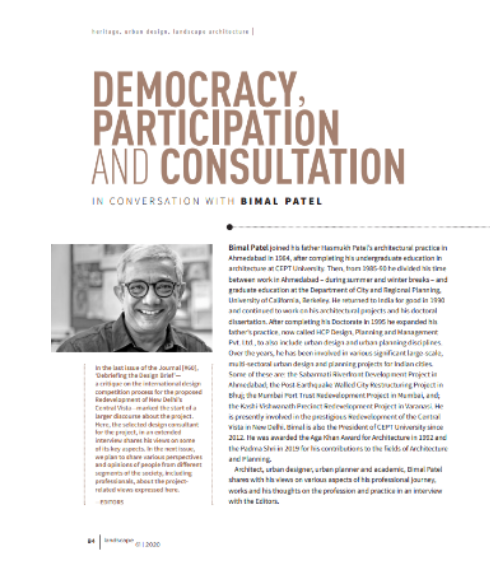
The city that Lord Hardinge envisioned in 1911 to testify to “the ideal and fact of British rule in India”7 was built as an instrument of the Raj, to communicate its assertion of power and authority on both a landscape and a people. Ironically, at the time of its completion in 1931, in the very week of its inauguration, “ delegates returned to India from the first Round Table Conference, which had been convened in London to chart the course toward Indian self rule. Leading British newspapers agreed that the co-incidence was “almost miraculous,” for it was now possible to regard Raisina as representing the government’s “altered spirit”. History would associate new Delhi with the beginning of real self -government ; its buildings would not be seen as “vainglorious gestures” of dominion and the trappings of imperial power, but rather as the offices and council chambers where India would plan and direct her own future.”9
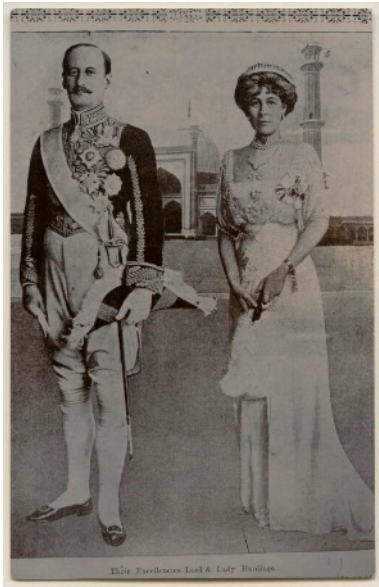
In 2011 the centenary of its foundation was marked by little in terms of either celebration or commemorative spirit. So much so that, Swapan Dasgupta writing in the “Times of India” on December 18, 2011 remarked of it that, “India had yet to develop the necessary self confidence to view history as history.”
HCP Designs’, the Patel Project lies at the intersection of these events – the making of New Delhi as an expression of Imperial will, the post-independence appropriation of it as both the symbol and the seat of self-governance and finally, through the current project, the site of both inscription and erasure, of memory and of a vision. Through its location at such an intersection, the manifestation of the Patel Project will underscore the role that legacy and collective memory play in serving as both impetus and point of departure. As constructed entities they are both intimately linked to the politics of power and the expression of will. In its’ manifestation the project would question the nature of the archive and articulate a position with reference to it – its spatial, material and symbolic narratives would serve as vehicles and agents of either the avant garde or the reaffirmation of the politics and aspirations of the past.
In doing so, the project would inevitably question whether indeed the archive is the keeper of legacy, does it serve as an anchoring device in a country where objects are constantly being endowed with new meaning and understood through others. Can it still be used as a mechanism through which to situate a work within a broader historical and conceptual framework? And lastly, through it what is the role of the critic and of criticism – is it to draw attention to the novelty of form, image and technology, are critics to be the curators and arbiters of taste, or is it their responsibility to make evident aspects of a work to a larger audience that may not seem immediately comprehensible? Is the role of the critic akin to that of a “translator” – a person who takes the work to a new public, who renders it accessible through a translative medium, while simultaneously situating it within the geography of past disciplinary practices and projective imaginations?
The purpose of this essay is to illustrate through predominantly a spatial critique the implications and opportunities that arise out of the current design. It is neither solely part of a greater historical narrative of the precinct and its development over the decades nor does it adopt solely a philosophical approach in examining the design scheme. While in the case of the former much urban history has already been written and documented about the central vista and its buildings, in the case of the latter either a prescriptive or canonical text written in abstruse language would potentially serve to alienate and marginalize readers who are not familiar with either the rarefied world of architectural and urban theory or those who may have a differing or opposing point of view.
Just as the city is residence to multiple and often divergent imaginations, this text is aimed at a diverse audience who are interested in the city of New Delhi and specifically the urban and architectural developments that are currently underway, and also those who view the landscapes of the city as being both a contested and a common ground. The scale and complexity of the central vista redevelopment project is such that it will always raise more questions than it can answer, it will redefine disciplinary boundaries and will call into question both the engagement and judgement of those directly engaged with its making and of those who through critical questioning and engagement serve not as the projects detractors but as its conscience keepers.
The “triumph of common sense”10 as Mr. Patel described his project inevitably has to navigate a minefield of often complex requirements and the concerns of multiple interest groups both within and outside of government. Heritage (how we see it, and what do we do with it?), its architectural and urban expression, the short and long term environmental and climatic impacts of the project, the central vista as both a cultural and civic space, the physical landscape of paths, water bodies and plantations, issues of project finance and its constructability, traffic management, the requirements of the government, and perhaps most importantly, as its’ vision – how do we wish to see our democracy expressed, all fall squarely on the shoulders of both the architect and of the government of the day.
It’s a tall order, but few architects in the country are as well equipped to address these concerns as Mr. Patel and few governments in the recent past have had such an overwhelming grip over Parliament to be able to put forth a project that Mr. Hardeep Puri, the union minister for Housing and Urban Affairs has described as Prime Minister Narendra Modi’s “dream project”.11
A lot has been both written and said about the project with most of these concerns falling broadly into three categories –
The first question the legitimacy of the process and its adherence to established norms of due process. The lack of public consultations and the manner in which contracts were / are awarded, permissions granted, and land use changed. Most of these articles comment on how the government conducts its business and its seemingly authoritarian nature.
The second set of concerns question whether for a project as large and complex as this, have the requisite research, impact analyses and projections been done to both inform early stage design decisions and also subsequently the impact of those decisions on the city and its citizenry.
And lastly, concerns have been raised about the projects attitude towards heritage, the landscape, its’ economic and climatic viability and its effect on the urban plan of the city.
The project has also galvanized public opinion with concerned citizens particularly those professionally engaged with the built habitat having coalesced and formed initiatives such as Lokpath India. They along with others have gone on record to highlight critical issues with the project and aberrations with the processes being followed.
Public space is the space of democracy, and just as the Lutyens plan is not sacrosanct, treating it so is neither an act of historical sensitivity nor is building on it an act of cultural betrayal. Likewise, public space too is not the spatial remnant after the building project is dusted and done, nor is it a utopic space to be bound by security cordons and made public only on days of national importance.
While I share and concur with many of the issues raised by my colleagues and would hope that both the government and the architect will adequately address them, it is important to note that in a democracy the ends do not justify the means. Democracies such as ours exist within the processes and institutions that empower self governance. The circumventing of such processes and institutions or the dilution of their autonomy strikes at the very root of our country’s democratic project and undermines the idea of modern India as enshrined in our constitution. Taken to an extreme, such an act can be described as unconstitutional and anti-national. Historically, one of the more potent vehicles to communicate political ideology has been architecture and through it the organization of public space. It is this attribute of the project that necessitates critical public engagement as a precursor to breaking ground on the project.
Public space is the space of democracy, and just as the Lutyens plan is not sacrosanct, treating it so is neither an act of historical sensitivity nor is building on it an act of cultural betrayal. Likewise, public space too is not the spatial remnant after the building project is dusted and done, nor is it a utopic space to be bound by security cordons and made public only on days of national importance.
It would therefore be irresponsible at such an important juncture in our nations history not to offer a critique of the design and its associated processes. “Constructive engagement” a term Mr. Patel uses in his interview “Democracy, Participation and Consultation”, is not about Bimal bashing, and if the following text appears to be so an apology must immediately be tendered.
The Urban Plan :
An Inheritance of Loss?
(3571 words, 15 minute read)
A perfect judge will read each work of wit
With the same spirit that its author writ,
Survey the whole, nor seek slight faults to find,
Where nature moves, and rapture warms the mind;
Nor lose, for that malignant dull delight,
The gen’rous pleasure to be charm’d with wit.
But in such lays as neither ebb, nor flow,
Correctly cold, and regularly low,
That shunning faults, one quiet tenour keep;
We cannot blame indeed—but we may sleep.
In wit, as nature, what affects our hearts
Is not th’ exactness of peculiar parts;
’
Tis not a lip, or eye, we beauty call,
But the joint force and full result of all.
Thus when we view some well-proportion’d dome,
(The world’s just wonder, and ev’n thine, O Rome!’
No single parts unequally surprise;
All comes united to th’ admiring eyes;
No monstrous height, or breadth, or length appear;
The whole at once is bold, and regular.12
The uniqueness of the Lutyens plan is that it is part landscape plan, part urban plan and part architectural ensemble that collectively gives Delhi one of its most defining urban features i.e a ring of density surrounding a relatively sparse center. The “center” or Lutyens Bungalow Zone was not always the center of the city and an understanding of contemporary Delhi as a collection of cities with “relational peripheries”13 is both more accurate and more helpful in recognizing that through its iconicity, the central vista serves as a magnet not only for the “multiple peripheries” that make the city, but also the differing and divergent imaginations that define the nation. The symbolic strength of the central vista, one that is etched both in public memory and collective consciousness is manifest as a cocktail of ideas of space both in terms of its meaning and of its use too. People from all over the country visit it, and through television and digital networks its image is projected to the hinterland. It is united by an idea of India that accommodates this difference.
The public space and the associated image of Rajpath and the central hexagon that we know was not designed to be a democratically configured public space. It was designed to be a processional space to be used to communicate through pomp and pageantry the power of the imperial empire. However, there is no doubt that in the years since independence we have appropriated it and made it our “own” through a series of incremental acts of varying spatial and social footprints. To intervene in it at the scale of both a redevelopment and a reimagining would require one to situate the project within the greater continuum of architectural, urban and cultural production.
At the outset the response to such a potent context is in the manner which the question is posed. The defining of intention as a premise for a work frames the context within which one can situate it and ask questions of the issues that arise from it.
The uniqueness of the Lutyens plan is that it is part landscape plan, part urban plan and part architectural ensemble that collectively gives Delhi one of its most defining urban features i.e a ring of density surrounding a relatively sparse center.
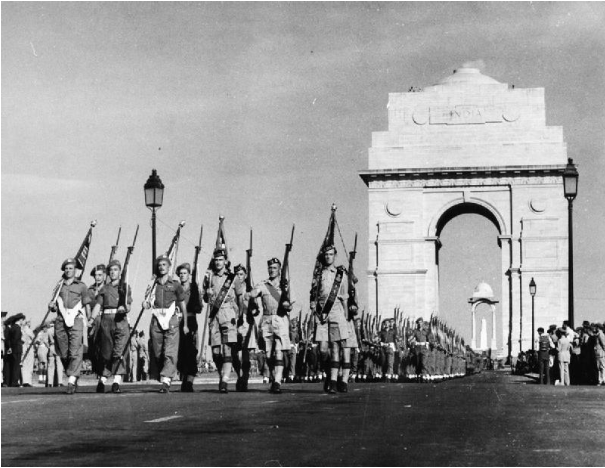
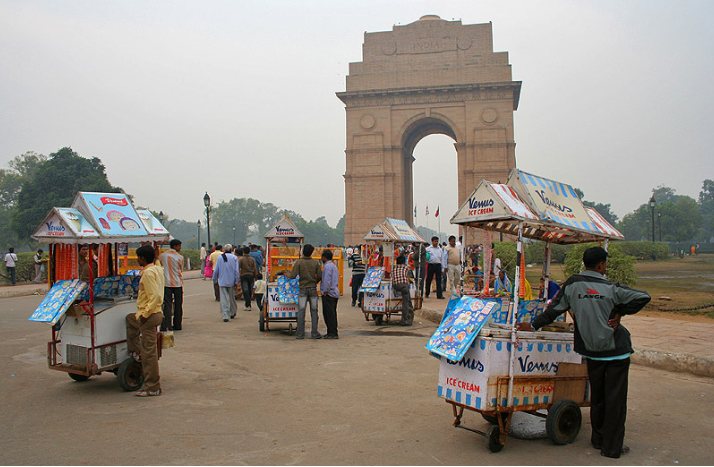
For example, if the intent was to express public space as the space of democracy then it would follow common reason to consolidate spaces that require security cordon or locate them elsewhere in the city so that more space within this precinct could be accessible to the public. While Mr. Patel has on a number of occasions clarified that the quantum of space accessible to the public is the same, in fact if you include the proposed arboretum it would have probably increased, without the insertion of programs that can act as both catalyst and infrastructure for occupying the space and enabling new forms of inhabitation, the space remains sanitized only to receive “publicness” when it is scripted or ordained.
The boundary walls of the proposed buildings create hard thresholds that encase Rajpath in the same manner as the city’s Lodhi gardens or Nehru Park do. The limited access points allow the space to be “opened” or “closed” making it “public” based on administrative order. The central vista is not an inner city park, a destination to be visited for recreation but the central element that knits together city’s physical and the country’s civic geography. The boundary walls convert land parcels into gated plots of land that erodes the “garden city” and “city beautiful” nature of the New Delhi plan.
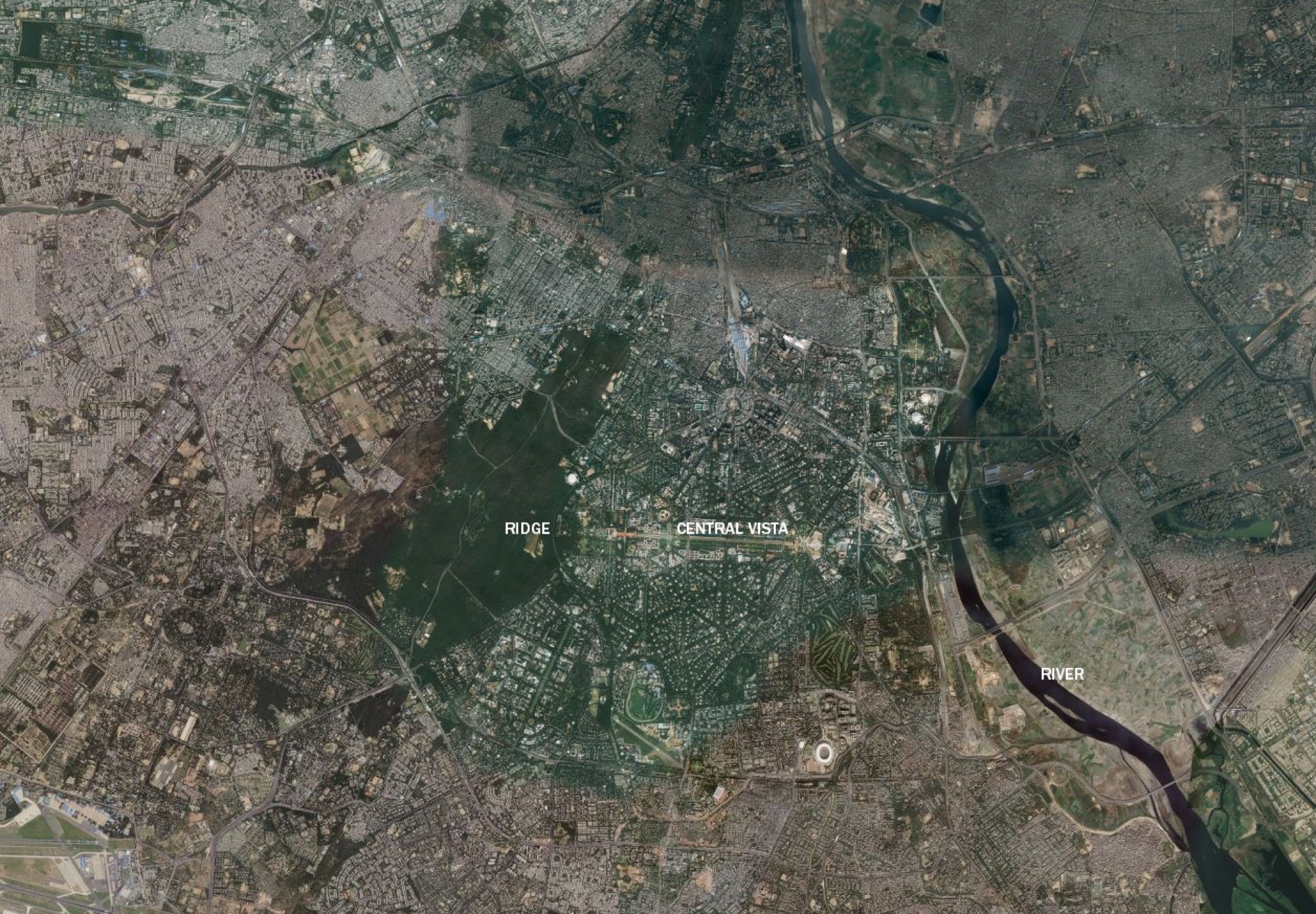
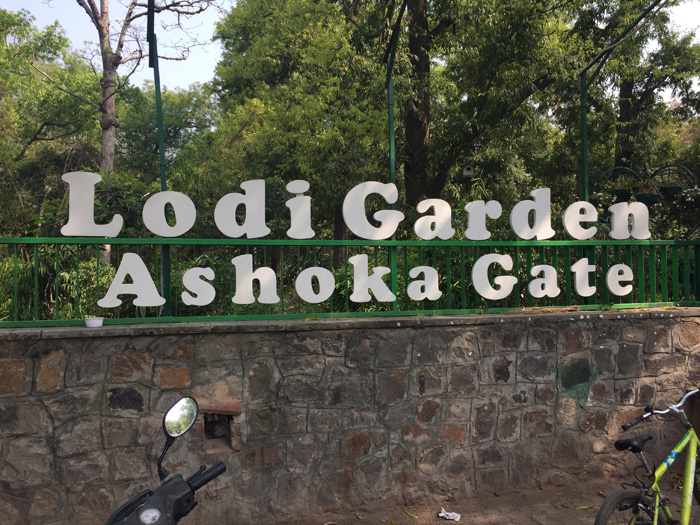
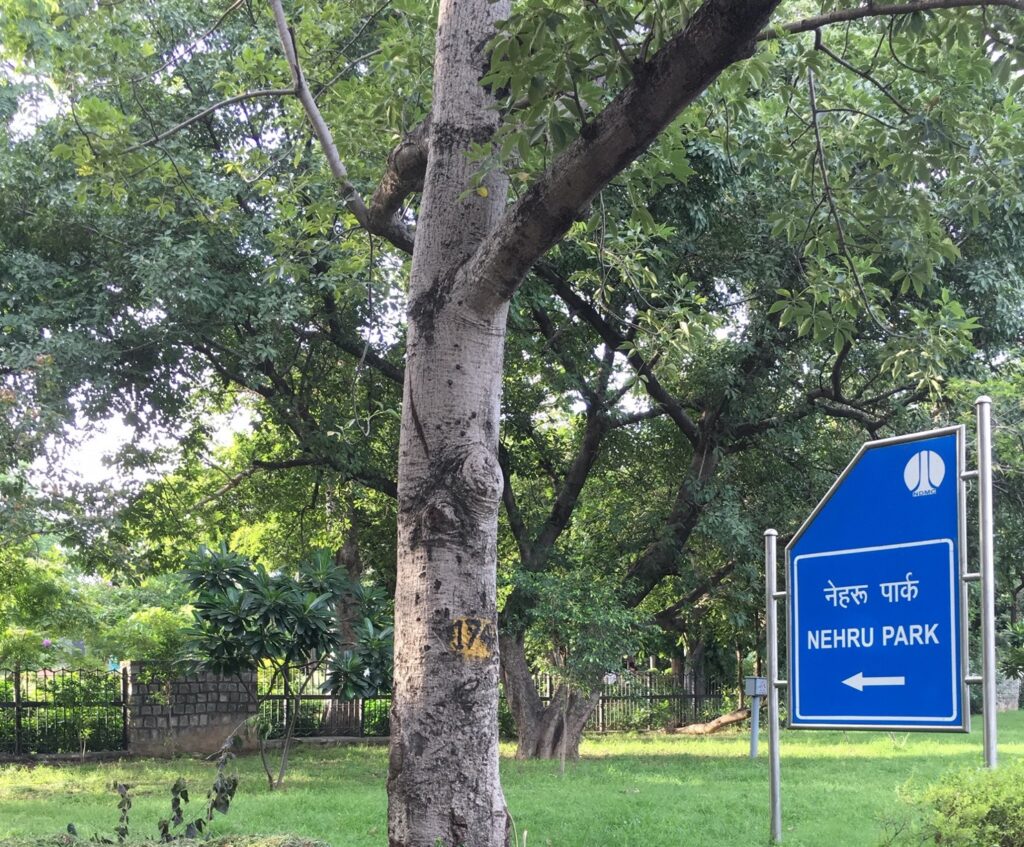
5. Aerial photograph of Delhi showing the centrally located Lutyens Plan, the ridge on the west and the river on the east. (Image Courtesy Bing)
The Patel project recognizes that the Lutyens plan connected the city’s ridge to the river and illustrates the zoning by defining the western edge as the space of, “The Nation – Geography People and History” as manifested through the biodiversity Arboretum, Rashtrapati Bhawan and the National History Museums (North and South Blocks). The Parliament and the Prime Ministers’ residence and office on either side of Rajpath make for the Legislature and the Executive, while the central secretariat as the Administrative arm of the government extends up to the end of Rajpath and the beginning of the central hexagon. The cultural zone as defined by institutions such as the National Gallery of Modern Art (NGMA), the proposed new location for the Indira Gandhi National Center for the Arts (IGNCA) and the National War Memorial are the prelude to the last of the zoning sequence on the eastern edge, one zoned for Leisure and Recreation ( the stadium, the Zoological Gardens and the proposed New India Gardens).
While diagrammatically this is a perfectly reasonable juxtaposition of programs, it is hard not to notice that they work efficiently independently of each other while making it inconvenient for the public to traverse through them.
Let me explain.
The proposed biodiversity Arboretum, carved out of the presidential estate is accessed from the west, along the ridge but does not traverse either through or around the presidential estate to allow access to the central court of the proposed national history museums. The security cordons around assets such as the prime ministers’ residence, the parliament and the national museums would make it difficult for a general public to freely access it. (Currently, public access to Raisina hill is restrained and with the presence of a prime ministerial residence once can only expect heightened security measures.)
Admittedly, the plots and the buildings that currently exist are to be the locations of the new central secretariat and hence the “status quo” as a nod to historical sensitivity would be maintained. The common boundary wall between successive buildings establishes not only a hard edge between them but also acts as a vehicle of urban segregation, and as mentioned earlier limits the points of accessibility to this central space. The central hexagon or the cultural zone that is on the eastern end of Rajpath is demarcated from the lawns of the central hexagon by fast moving traffic. And while potentially the creation of underpasses and an electric bus route connecting the buildings and the rest of Rajpath would make this space available to people, it objectifies the space and creates static islands of the buildings and the programs that define it. Consequently, the spatial void defined by the buildings is not designed as public space but is in fact residual space that will in time be appropriated by people.
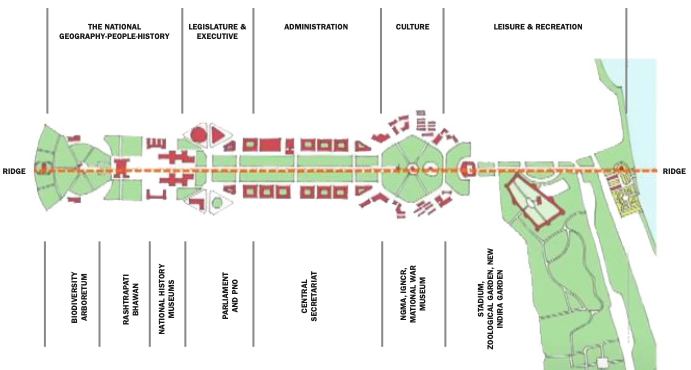
Ironically, accessible from the central vista is Copernicus Marg a road that is punctuated by the Mandi House roundabout and which terminates at Bengali Market. Along this road and its immediate environs is Bahawalpur House which now houses the National School of Drama, the Sriram Center, Sangeet Bharati, Triveni Kala Sangam, Sapru House and Rabindra Bhawan, all of which collectively contribute towards an art district that could with sensitive urban design be integrated into the “culture” zone of the central vista redevelopment proposal. A north – south urban design intervention could weave the institutions around the central hexagon with those along Copernicus Marg / Mandi House and terminate naturally at the eateries of Bengali Market.
The potential of extending the public realm and creating a public space that takes as its point of departure the uniqueness of the geography within which the Lutyens plan exists and the city’s recent architectural and urban history is an opportunity lost at a historical scale.
Similarly, the stadium, zoological gardens and the New India Gardens that form the recreational and leisure zones exist independently of each other and don’t serve as a vehicle that could otherwise have through the pedestrianization of the east -west axis and the north – south cultural corridor created one of the most remarkable public spaces in the world. It seems regrettable, that we have sacrificed the potential of a “more inclusive and public” future as a cornerstone of our democracy for the familiarity of and allegiance to a colonial era plan under the pretext of creating greater administrative efficiency.
Consequently, the spatial void defined by the buildings is not designed as public space but is in fact residual space that will in time be appropriated by people.
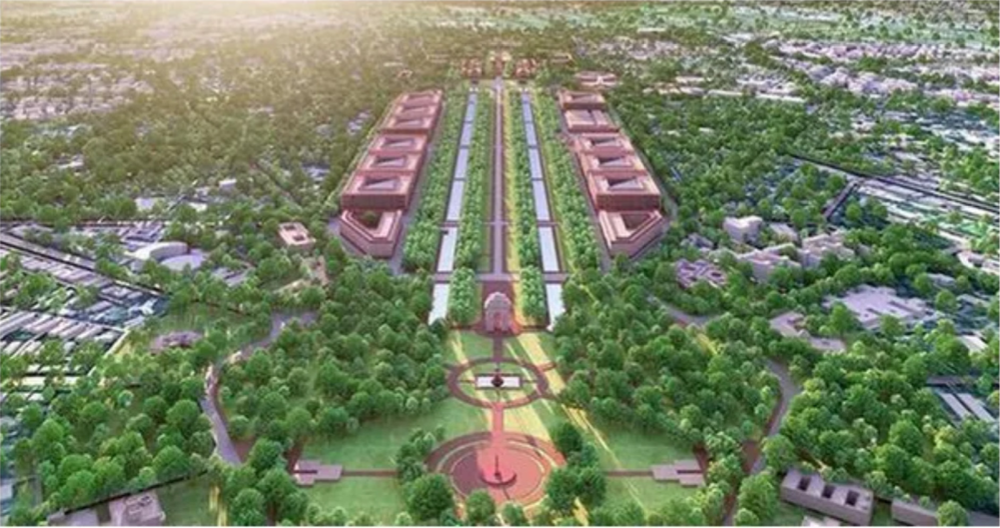
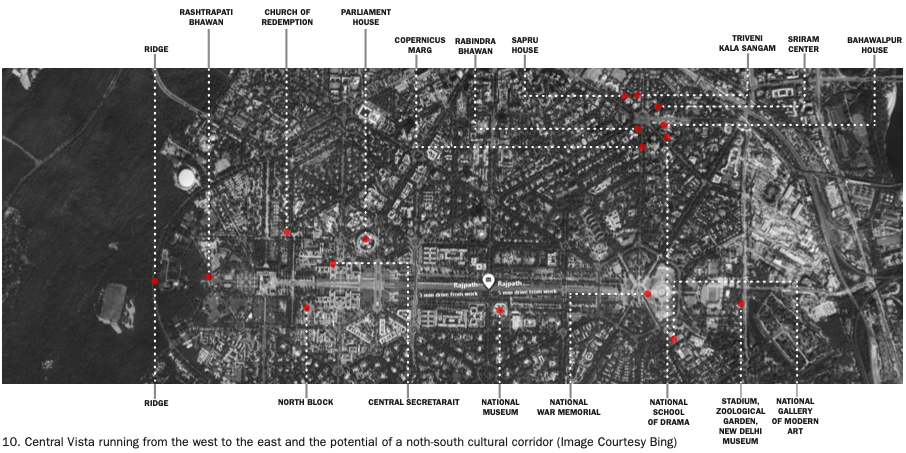
It is indeed plausible that the expansion of the public realm as a means of furthering the democratic project and integrating otherwise disparate parts of the city, by making it more accessible to the citizenry was not the primary objective of the project. After all, one can argue that the current space is both familiar and by virtue of having stood the test of time has all the elements of a good urban space already in place. Consequently, why would one need to re-structure it if relatively smaller incremental improvements can make for a quantum improvement?
If the question was to be reframed and the intent articulated as the need to create the infrastructure for greater administrative efficiency for the effective functioning of the central government then one would be compelled to look more closely at the proposed buildings of the central secretariat and situate them within what we can expect to be the life expectancy of the buildings and what urban or architectural strategies would make them more efficient.
It would be worthy to note that when Shastri Bhawan, Krishi and Rail Bhawan were built they were done for the very same purposes that the proposed buildings are being built i.e. to enable greater administrative efficiency. Like the proposed buildings they too were for their time “modern and efficient”, they too, just as the current buildings would in years to come, represent a period within the greater continuum of the city’s architectural and urban history and thinking. And hence, the perceived inadequacies that necessitate their demolition (as against renovation for example) should not be repeated in what we construct next.
The infrastructural inadequacies, their disorderliness, and the spatial inefficiencies that Mr. Patel describes as the reason for their necessary demolition have occurred in part because the size of government has grown considerably and the buildings weren’t designed to cope with either an increase in the number of people working in them or the technology that would be needed to support them. And, while one will discuss this at greater length in the subsequent section of this text, with respect to the urban plan the concentration of a set of mission critical buildings in close proximity to each other raises three critical questions.
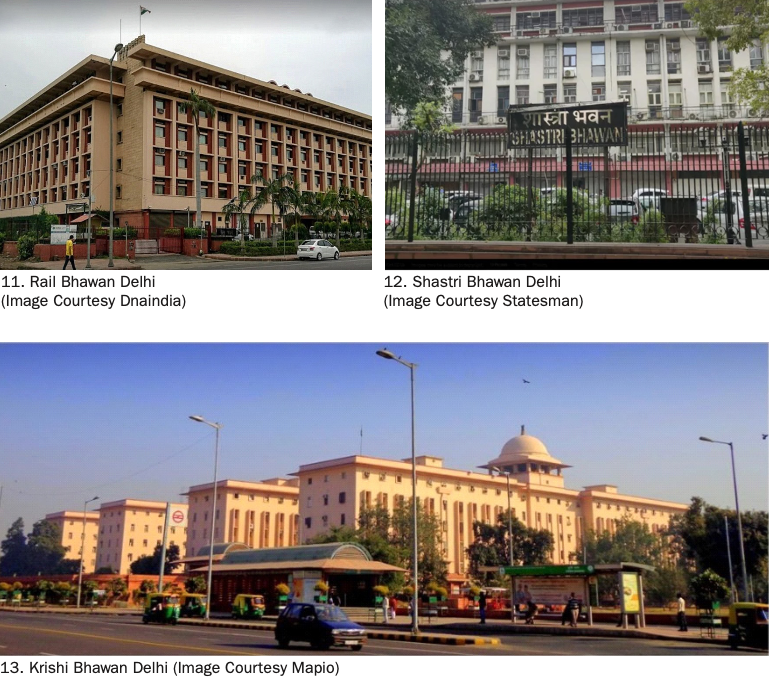
The potential of extending the public realm and creating a public space that takes as its point of departure the uniqueness of the geography within which the Lutyens plan exists and the city’s recent architectural and urban history is an opportunity lost at a historical scale.
The first of these is concerned with the consequences of over centralization and the excessive dependence of physical proximity as the primary agent for workplace efficiency. It would be important to note that while demographically the current generation of people who work in these offices (in relation to the technology they use) are digital immigrants future generations would be digital natives and hence equally, if not more effective in communicating through a digital medium than one facilitated through physical proximity.
At the outset the concern with large centralized government is not so much the opportunities it creates (after all, should you wish you can work digitally with the person sitting ten feet away as well) but the opportunities that are lost as a result of such a decision.
Let me elaborate.
Our understanding of space and the manner in which we use it has changed dramatically. At the expense of repeating the influence of digital media on it, administrative efficiencies are equally a function of flexibility (can we re configure the space and to what extent) as they are about spreading risk (from terrorist attack, pandemics etc.) and minimizing the “downtime” as a result of it. At times, administrative efficiency is best achieved by working “in the field”.
Does for example the ministry of tribal affairs have to be on the central vista or can it be located in another part of the country? Will its location elsewhere enable it to work more efficiently? Can the location of central ministries in different parts of country serve as the impetus for local urban growth and regeneration. Would it better communicate to a country at large that ours is a government by the people for the people and working in the midst of the people?
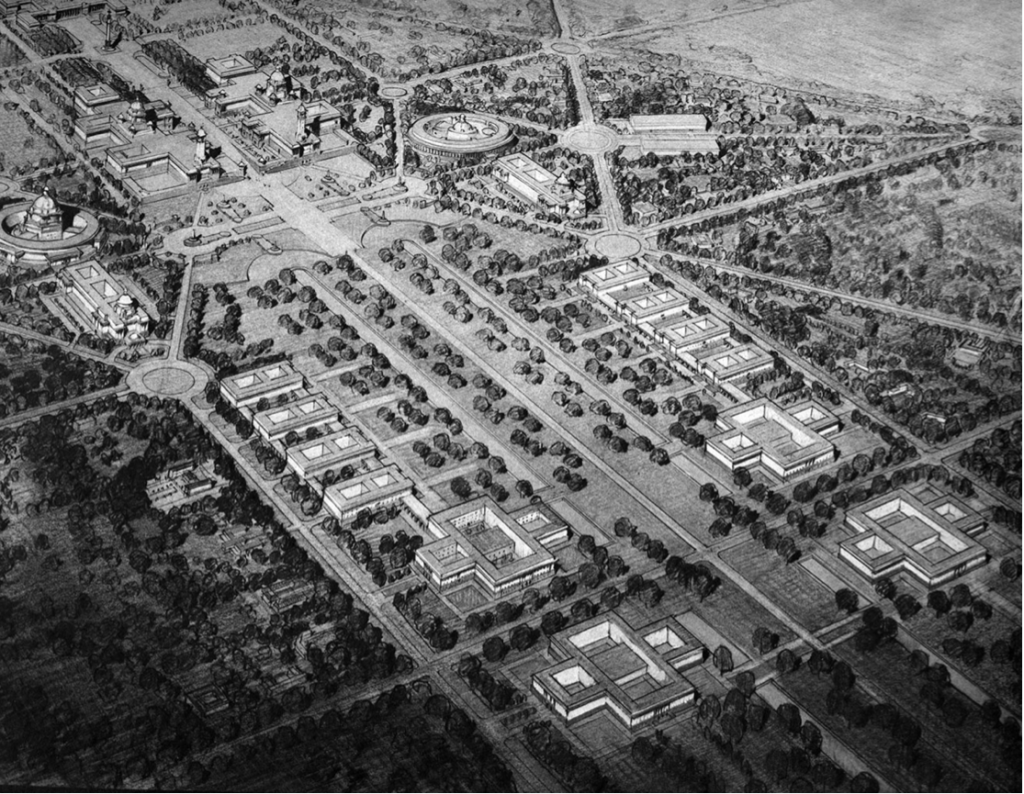
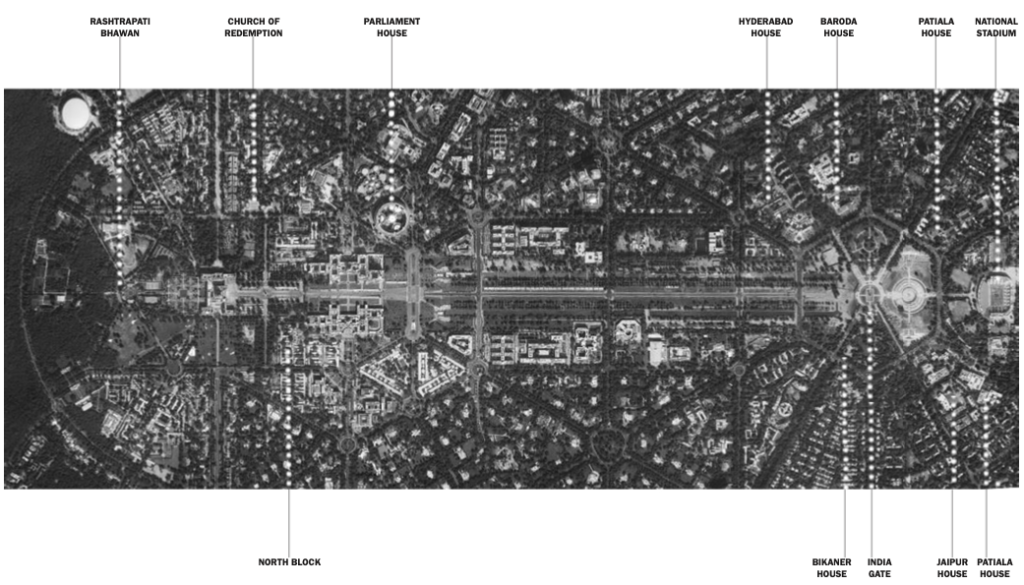
The debate around the centralization and decentralization of government or whether a judicious mix of the two is an appropriate strategy or not is as important a question as are those regarding the adaptive re-use of the current buildings. (While there is no doubt they are in a state of disrepair and need infrastructural improvements the question is do they need to be torn down and if so will what replaces them follow the same lifecycle trajectory? Would we have learnt from our mistakes?)
Irrespective, the current redevelopment and redesign scheme advocates the need for a large centralized government. And, if physical proximity is going to deliver good governance and efficiency then in keeping with Delhi’s urban history as a city of cities, at seventy-five years since independence let modern Indian build its own administrative capital. Freed from the shackles of a colonial imprint presented with opportunities a new, the new city can further cement the need for physical proximity by incorporating not only new offices for the government but also housing!
But clearly this is not the intent.
The second question is whether to view cities and specifically the precinct around the central vista as solely an economic and administrative vehicle. On innumerable occasions Mr. Patel has remarked on the economic value of the land and the potential loss on account of the army barracks and other such structures that are present there and could otherwise be located elsewhere in the city. While cities may be in part economic vehicles, they are primarily human habitats. In India this is expressed by its commitment to being a republic and manifest not only through the institutions and processes of a democracy but also through its commitment towards creating and maintaining civic and cultural spaces.
The second question is whether to view cities and specifically the precinct around the central vista as solely an economic and administrative vehicle. On innumerable occasions Mr. Patel has remarked on the economic value of the land and the potential loss on account of the army barracks and other such structures that are present there and could otherwise be located elsewhere in the city. While cities may be in part economic vehicles, they are primarily human habitats.
The Patel project while professing to share an allegiance with the Lutyens plan in an act of historical reverence, distinguishes itself from its predecessor in the manner in which it views civic and cultural space.
Lord Hardinge, as the Viceroy of India along with Lutyens and Baker was the protagonist behind Imperial Delhi. As a diplomat having served in London, Constantinople (Istanbul), Berlin, Sofia, Bucherest, Tehran, St. Petersburg and Washington D.C. he was not only familiar with urban culture but equally well acquainted with Pierre Charles L’Enfant’s plan for Washington D.C.
While the Washington plan was to greatly influence the design of New Delhi, it would be noteworthy to point out that in both plans flanking the central axis were civic structures like monuments and museums. Publicly accessible, through the density and diversity of programs they contributed to making the central spine a place for the people.
Bimal Patel’s project lines Rajpath with impregnable boundary walls and pushes the cultural institutions to its western and eastern edges. In doing so, it adopts an approach that segregates the public on one hand and “contains” the people working within the buildings on the other. The plan does little to promote a civic agenda for the space.
As part of President François Mitterrand’s Grands Projets, the Finance ministry in Paris was moved out of the Louvre to create more exhibition space. I.M. Pei the Chinese American architect was tasked to restructure the museum and through the insertion of a glass pyramid gave new meaning to the Napolean Court. With both North and South Block in New Delhi slated to become museums, there are undoubtedly similarities between the two projects. A key difference however, is the manner in which Pei integrates the buildings that define the Napolean Court and Patel’s indifference towards either creating a civic space between North and South block or through a subterraneous link uniting the two proposed museums.
By virtue of its location on Rasina hill, with Rashtrapathi Bhawan in its proximity this space presented the opportunity to either re-affirm ones commitment to the authority of a colonial plan or through the insertion of civic programs and linkages transform it into a more egalitarian space. By virtue of re-locating the prime ministers residence here, the decision not to create open civic spaces coupled with the centralization of government buildings along the central axis it re-affirms the colonial project of communicating absolute power and authority.
Through the development of a static plan that is neither spatially elastic nor resilient the central vista redevelopment project turns a blind eye towards indigenous forms of urbanism. While the adoption of strategies learnt from “the street” would infuse a dynamism into the space it would consequently script a program that defines the central vista as not only as an economic and administrative construct but equally a social habitat as well.
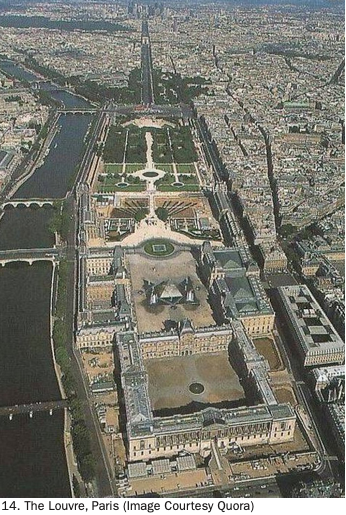
The design strategies through which this could be manifest are multiple and while it remains within the prerogative of the architect to chose what they believe is an appropriate approach, the freeing up of the ground plan while giving direct access to the offices above from the under ground rail system and basements would create a new publicly accessible civic space.
Architecture is the product of the dilemmas that define its conception, the factors that influence its construction and the subsequent appropriation of the object by those who inhabit it and by that within which the architectural object is situated. It is a vehicle that through an act of natural selection and mediation is an agent for the empowerment of people.
The central vista was not conceived of as a plotted development and making it so undermines the reality that architecture exists within the crucible of a greater humanitarian and environmental landscape. Vittorio Gregotti the Italian architect and theorist elaborates on this by saying,
“This ideal of landscape as total environment, in which I have tried to situate architecture, forces us not to conserve or reconstruct specific natural qualities but to recognize the materiality of the anthropo-geographical environment, as a field in which architecture operates, and continues to convey meaning; and to acknowledge its importance as something indispensable, which can be understood as a structural principle of the environment, even outside the existing cultural model.”
The central vista project as currently manifested does not view the urban plan as a field within which architecture operates, mediating between the multiple realities that constitute it, it does however, through a series of seemingly rational responses to individual and independent aspects of the project create the illusion that collectively they would create a greater whole.
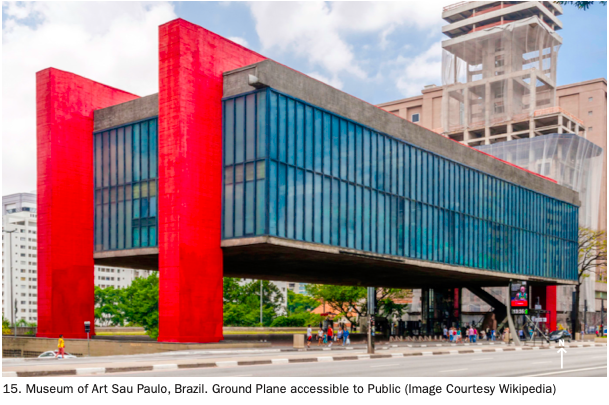
Urban planning is as much an agent of democracy and democratic process as is the effective functioning of an accountable government.
In concluding his presentation at CEPT, Mr. Patel quoted Lord Foster as saying, “If the House of Lords is to be relocated north, we must use the power of architecture to express our political and economic ambitions… We should take our cue from the 19th century, which understood how great buildings can demonstrate confidence in our future”. And so, with the redevelopment and redesign of the central vista this is our opportunity to give shape to a voice that articulates what we understand and envision for India not only at seventy five but also for the decades and centuries ahead. The mere pragmatics of construction and occupation, of realizing the value of land and making convenient what already exists is a poor comment on what could otherwise have been. Urban planning is as much an agent of democracy and democratic process as is the effective functioning of an accountable government.
The Patel plan represents the loss of an opportunity to imagine a new – in fact, the current plan completes the Lutyens plan and hence furthers its purpose. Through a process of “solving simple problems in a way that keeps the structure in place”, to create a “unified whole”, in essence reaffirms the colonial project. Without any public participation or parliamentary debate, the title of the interview “Democracy, Participation and Consultation” in the Journal of Landscape Architecture (issue 61) rings hollow.
Furthermore, the process as it currently stands marginalizes not only those who have considerable knowledge and insight in the history, architecture and urban form of the city but also the city and country’s citizenry. Regrettably, by hiding behind the veil of “the triumph of common sense”, Mr. Patel and those in government who commission such a work have missed the wood for the trees. The current process alienates and marginalizes the very people for whom the public space is being created and for whom the government is working. The urban plan as currently presented lacks ambition and regrettably is more of an opportunity lost than one of urban gain.
Architecture : On a Firm Ground with Weak Foundations?
(4809 words, 20 minute read)
Yet if we look more closely we shall find
Most have the seeds of judgment in their mind;
Nature affords at least a glimm’ring light;
The lines, tho’ touch’d but faintly, are drawn right.
But as the slightest sketch, if justly trac’d,
Is by ill colouring but the more disgrac’d,
So by false learning is good sense defac’d;
Some are bewilder’d in the maze of schools,
And some made coxcombs Nature meant but fools.
In search of wit these lose their common sense,
And then turn critics in their own defence:
Each burns alike, who can, or cannot write,
Or with a rival’s, or an eunuch’s spite.
All fools have still an itching to deride,
And fain would be upon the laughing side.
If Mævius scribble in Apollo’s spite,
There are, who judge still worse than he can write.
Civic architecture in Delhi broadly falls into two categories. The “rational revivalists” build on the material palette and symbolic traditions of both a recent and distant past while subjecting designs to the rigours of rationality. At times for the sake of expediency and to leverage on the familiarity of past work and effort, references are drawn from their (the architects) own portfolio. The “interpretive technologist” on the other hand, looks at either different ways of using established technologies (and arguments) to create solutions for a new set of problems or to create opportunities for new forms of living and working.17
The former with its relatively conservative approach and greater comprehensibility by those who commissioned the work has undoubtedly found far greater currency than the confidence and leap of faith required for the more avant-garde approach of the interpretive technologist. This coupled with the twin approaches of intentionality that defines the context within which questions regarding the project are raised, and through the convergence of approximations, the definition of a field of practice provide an interpretive schema and the coupling device necessary through which to view the architectural proposals of the central vistas “re-imagining and redevelopment” projects.
The urban plan for New Delhi shares an affinity with the other great capitals of the world – Charles L’Enfant’s Washington D.C., Walter Burly Griffin’s Canberra, Albert Speers unbuilt project for Germania, and Georges-Eugène Haussmann’s Paris for example. While their rigid geometries and strong axiality are both assertive and potentially straight jacketing, the architecture that inhabits the urban plan is both more forgiving and malleable. The colonial architecture of New Delhi with the influences and precedents of both western classicism and the architecture of the greater Indian sub continent is no exception.
Specifically, the high plinths with small windows, the tall colonnades capped with domes, the dual toned sandstone clad walls, the deep verandas and a varied typology of building forms and spatial diagrams, all form a point of departure for the proposed buildings of the central vista. These buildings including those slated for demolition are a repository of time-tested knowledge. Ignoring them or painting all of them with the same brush would demonstrate an arrogance that we can ill afford.
Once again, with relatively little in the public realm regarding the architecture of the buildings, the following text is restricted to the office blocks of the central secretariat and to the proposed new parliament building. Specifically, their relationship to the site, the organizational principles behind the plan, the constructive assemblages as evident in the sections and lastly what we can understand through the buildings elevations as being the mediator between an external landscape and an internal one.
Whether through long held theoretical commitments or simply through the poetics of construction and pragmatism, the buildings of the central vista complex need to be both urbanistically considered and urbanistically considerate for them to capture the zeitgeist and to subsequently gain public affection. By virtue of the potency of the site any intervention on the central vista and especially that of the scale of the redevelopment plan being proposed would have to adhere to the highest standards of designs’ processes and methods.
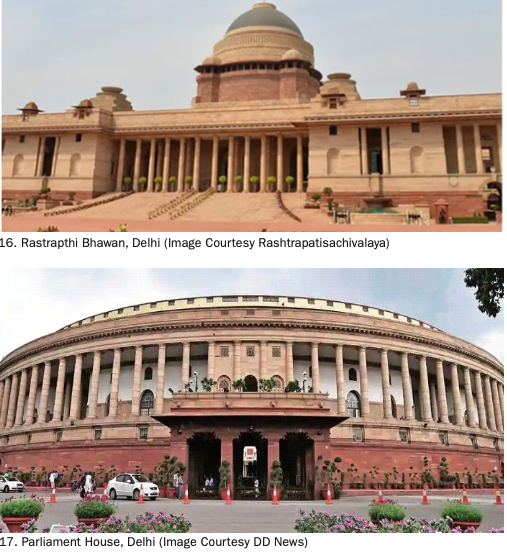
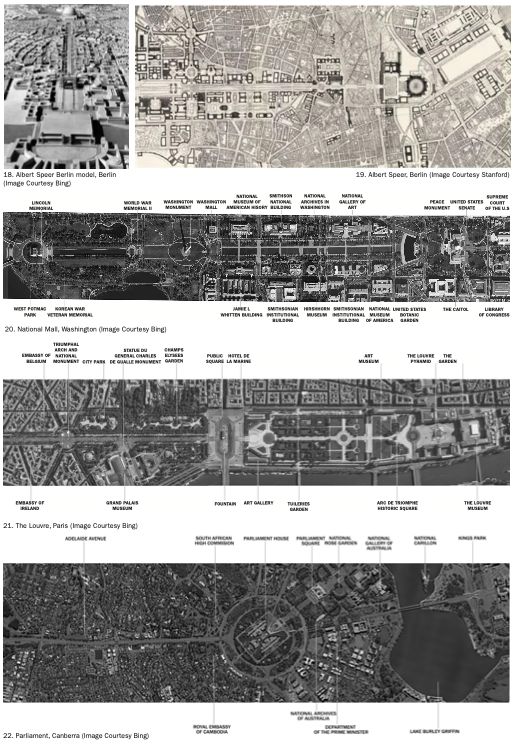
At the outset, the buildings of the proposed central secretariat largely identical in their manifestation are bound together by a boundary wall and further segregated from the vista by the parking lot and water bodies that line the central avenue. Accessible either through an underground rail link that is in turn connected to the city’s metro-lines or from the adjoining roads that surround it, the four islands within which the ten office buildings are situated are reminiscent of larger self-contained office parks.
The new buildings are proposed within the existing plot lines of what they replace and hence at first glance they would appear to be agents of continuity. As super blocks enclosing within them a number of buildings, through their containment reside within the city but are critically apart from it. Their insularity is in stark contrast for example to the cultural plaza that was proposed in the original Lutyens plan. (The cultural plaza was to be at the intersection of Rajpath and Janpath and defined by four buildings – the Oriental Institute, the National Museum, the National Library and the Imperial Record Office.18 Of these four only the National Archives was built.)
Within the plot lines as identical blocks placed parallel to each other there is nothing remarkable about their siting. As an expression of fire and security norms, set back laws, and other such quantifiable criteria the site plan appears to be the product of a reasonable set of responses to highly quantifiable criteria. And while one might argue that the reduction of an architect to solely an intermediary between quantifiable data and the built form is unfortunate, the large courtyards within the buildings that would act as social condensers for the office goers is perhaps its most redeeming attribute.
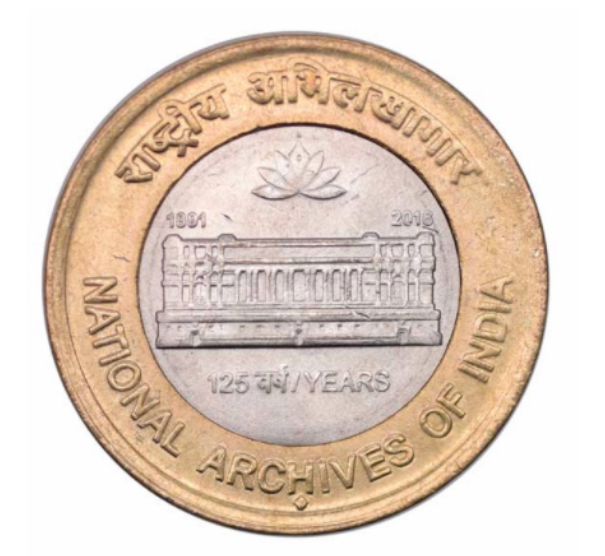
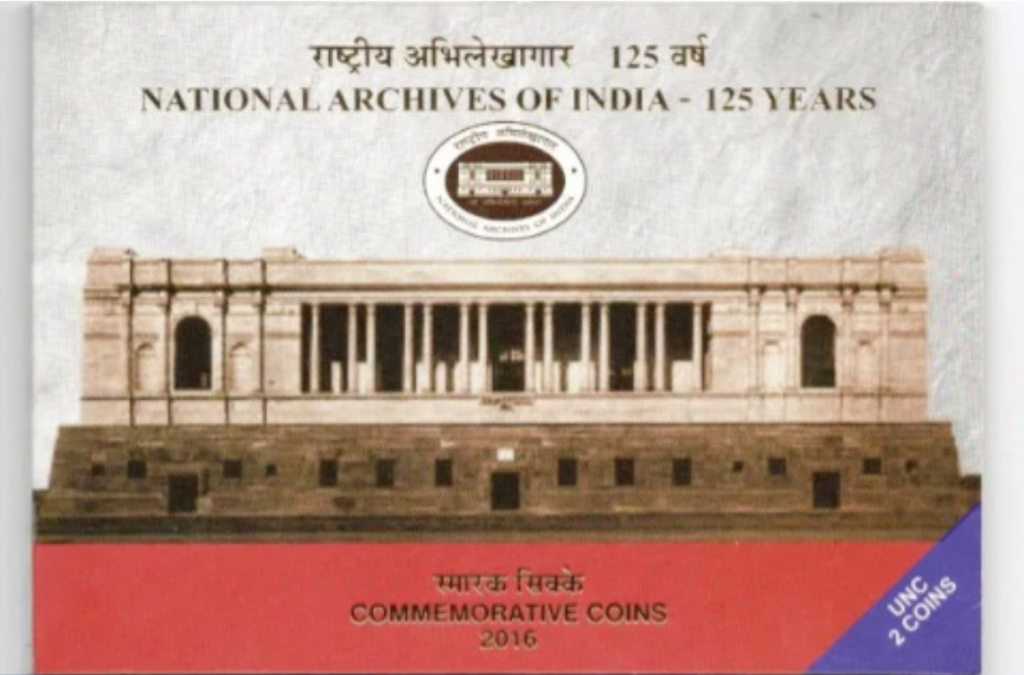
Whether through long held theoretical commitments or simply through the poetics of construction and pragmatism, the buildings of the central vista complex need to be both urbanistically considered and considerate for them to capture both the zeitgeist and to subsequently gain public affection.
Accessible either through the openings within the built form (through which a fire tender would pass) or through the highly articulated and sophisticated corner detail of the block, this central space as currently depicted in the renderings is predominantly glazed. While one can speculate that a curtain wall system is being used, what is evident is that the more “modern” and “technologically” forward glazing system is placed facing the buildings’ interior courtyard while the more traditional and conformist stone is placed on the buildings’ city facing façade.
On closer scrutiny, the elements that define the buildings elevations have been cherry picked from typological referents that are found both in the works of other architects and in Mr. Patels own portfolio. Specifically, Louis Kahn’s Indian Institute of Management of 1974 in Ahmedabad and Mr. Patel’s extension to the campus in 2009 come immediately to mind. Subsequent to this Mr. Patels Gandhinagar project of 2013, Swarnim Sanku, and lastly anchoring them within the greater Lutyens, Baker and now Patel project is New Delhis’ and Lutyens’ National Archives building.
It is not to suggest that through these projects Mr. Patel defined his own “Jeypore Portfolio”, but through the identification and appropriation of elements and techniques of past buildings, Bimal Patel demonstrates a humility that acknowledges that a familiarity with the past is worth more than the opportunity of the future. And without asserting value on one strategy over the other it is evident that as a rational revivalist, Mr. Patel frames his work as an interpretive technologist within a field of practice that identifies elements that serve as both agents of continuity and change.
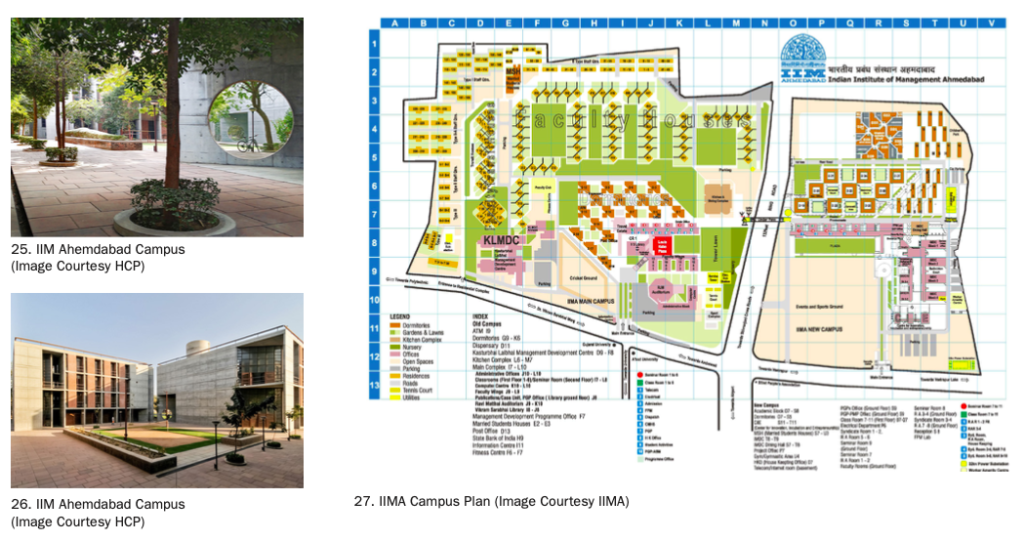
The new buildings at both IIM Ahmedabad and even at the CEPT university campus establish a material continuity through the extensive use of concrete with the greater modern project and through it both align and distinguish themselves from their predominantly exposed brick neighbours. In recognizing that material and morphological manoeuvres can be a vehicle for design method and intervention particularly in historically charged sites, Mr. Patel demonstrates his deftness in engaging with architectural conditions that require him to make comprehensible his design to project stake holders who vary from having absolutely no interest in architecture and urbanism to its’ conscience keepers.
However, does such method and continuity imply a lack of imagination and vison? Can we expect constructive assemblages and architectural details that use the traditional materials of the New Delhi project to address the exigencies of contemporary India and its projected future? Alternatively, will the project resort to parody and pastiche through the use of trite narratives to embed “the symbols of India” in the project and into our collective imagination, will this be our “Baahubali moment”?19 With little detail of the project in the public realm we can at this stage only speculate on the final order of things to come.
Interestingly, while in the city facing façade of the buildings of the central secretariat are evident elements of Kahn’s architecture in Ahmedabad (the circular cut-out out on the diagonal brick wall, an element repeated in the new campus but in concrete, the buildings corner detail, the compositional strategy of the façade and the buildings rhythm of windows etc.) in the interior overlooking the central courtyard the reference to a simplified but technologically enhanced India Habitat Center is unmistakeable. Stein, Doshi, Bhalla’s 1992 project in New Delhi like the Patel proposal creates an inner landscaped sanctum shaded through plantations and an overhead space frame. Arguably, with a seven story high red sandstone wall framing a glass façade could possibly also be seen as reminiscent of Charles Correa’s 1986 LIC building also in New Delhi.
The rationality exercised in such judgment only goes to show Mr. Patel to be an astute architect knowing fully well that through the collage of such continuities he will both align himself with Delhi’s much revered buildings, free himself from the shackles of a colonial past and create a series of uncontroversial and highly efficient office buildings.
Ironically in 1931, Robert Byron writing in the Architectural Review said of Herbert Baker’s recently completed Council House (Parliament Building), “…… there is all the difference in the world between “Fusion” and “Allusion”. The first is the use of diverse architectural inventions and ornamental themes, whatever their dates or racial origins, simply for their practical value in creating an artistic unity and in giving effect to the values of Mass, Space, Line and Coherence in the whole design. The second is the use of these same inventions and themes in a mood of reminiscence – the mood of the nineteenth century – regardless of their relevance to mass, space, line and coherence. The inventions and themes may be virtuous detachment but become ineffective and even hideous in conjunction with one another and with the building to which they are attached.”20
through the identification and appropriation of elements and techniques of past buildings, Bimal Patel demonstrates a humility that acknowledges that a familiarity with the past is worth more than the opportunity of the future.
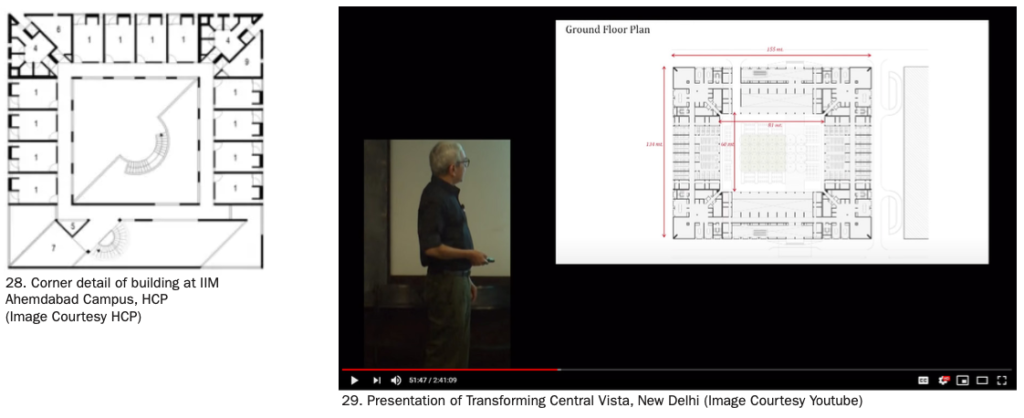
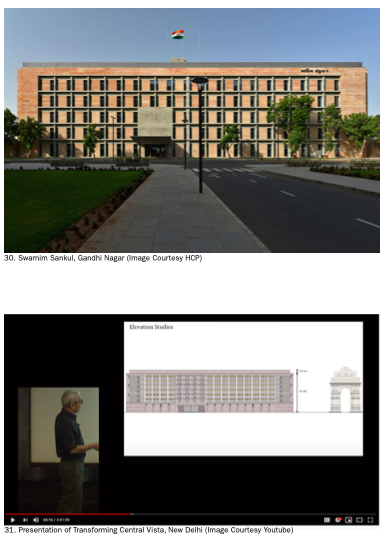
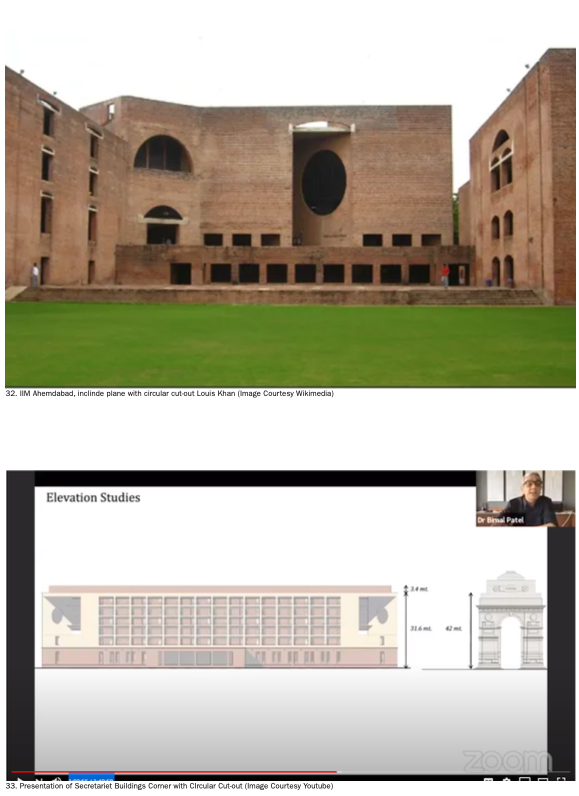
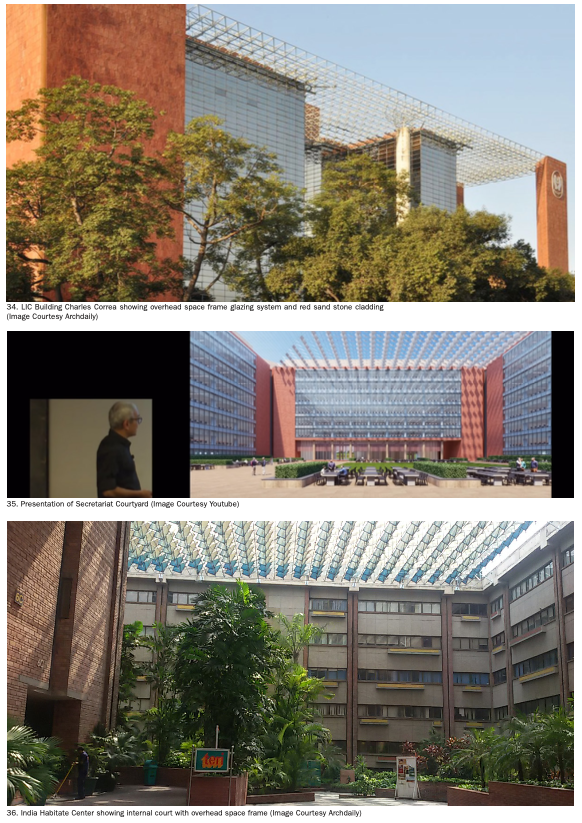
However, does such method and continuity imply a lack of imagination and vison? Can we expect constructive assemblages and architectural details that use the traditional materials of the New Delhi project to address the exigencies contemporary India and its projected future? Alternatively, will the project resort to parody and pastiche through the use of trite narratives to embed “the symbols of India” in the project and into our collective imagination, will this be our “Baahubali moment”?
Interestingly, preceding Byron’s 1931 comment, and writing in 1912 before he had been selected to work on the Delhi project Baker wrote in the Times what could in part echo Patel’s own thoughts, “there must be no conscious straining after invention or originality ….. There must be good building and a frank acceptance of modern methods and materials. The controlling mind must heat and weld into his orderly conception all that India has to give him of subtlety and industry and craftsmanship. And lastly, he must so fire the imagination of the painters, sculptors, and craftsman of the Empire, that they may, interfusing their arts with his, together raise a permanent record of the “history, learning, and romance” of India.”21
The building project as Byron quite rightly points out is simultaneously a terrain for other trades to practice their craft. The “controlling mind” that Byron refers to must in its “orderly conception” not only give opportunity to other forms of participatory collaboration but also through a “frank acceptance of modern methods and materials” be in a position to evaluate and advise dispassionately the need for and implications of such a large building.
The proposed Parliament building at 65,000 square meters is to be erected opposite the existing 45,000 square meter Parliament22, which is in proximity to both the 50,000 square meter Parliament Library23 and the 40,000 square meter Parliamentary Annexe building24. Collectively, at 200, 000 square meters or 21,52,000 square feet they are to serve a current capacity of 543 members in the Lok Sabha and another 245 Rajya Sabha members. The proposed new building is intended to serve a projected 876 members of the Lok Sabha and a joint session of the two houses of 1224 members. An increase in the country’s population requires greater representation.
The rationality exercised in such judgment only goes to show Mr. Patel to be an astute architect knowing fully well that through the collage of such continuities he will both align himself with Delhi’s much revered buildings, free himself from the shackles of a colonial past and create a series of uncontroversial and highly efficient office buildings.
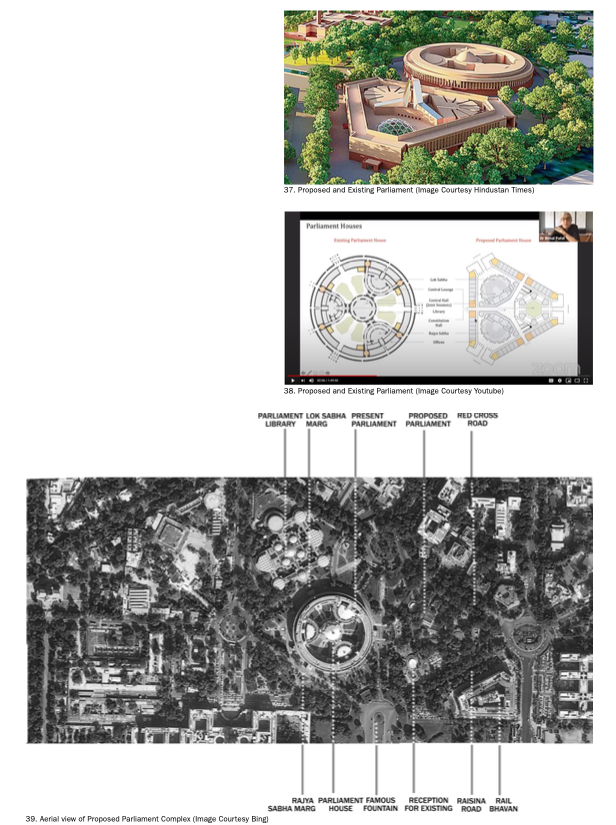
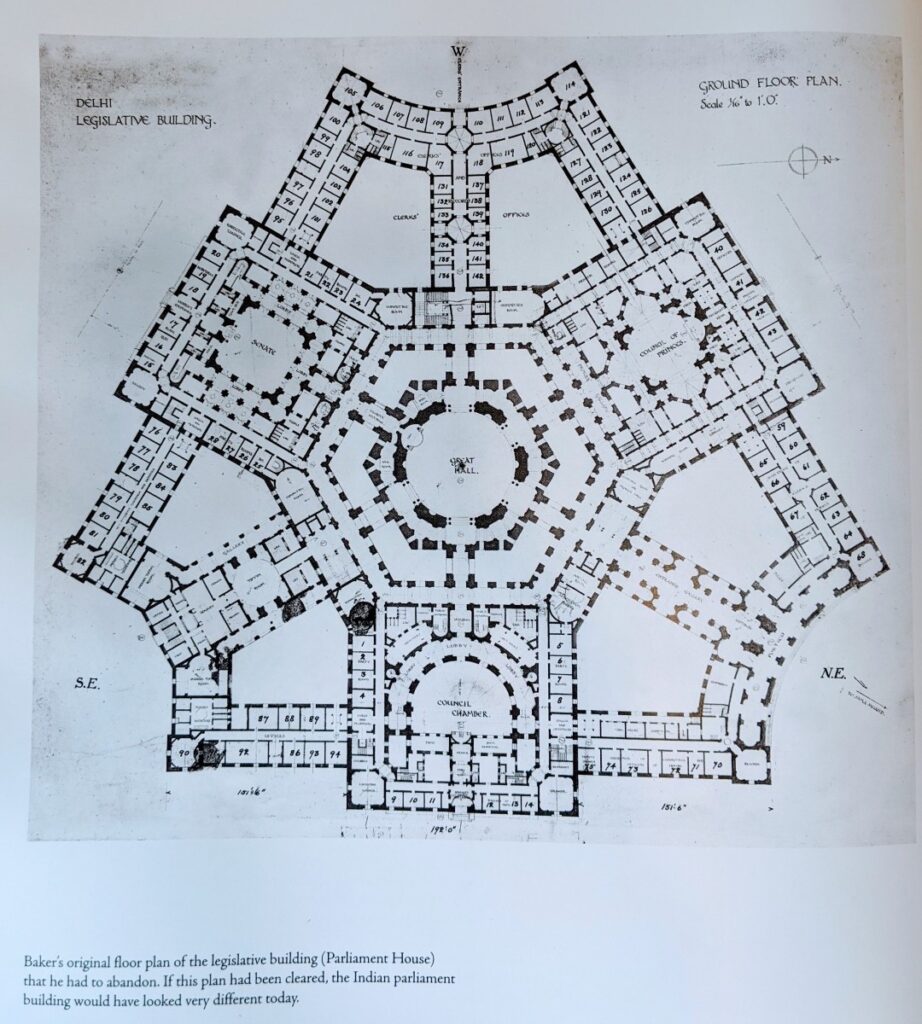
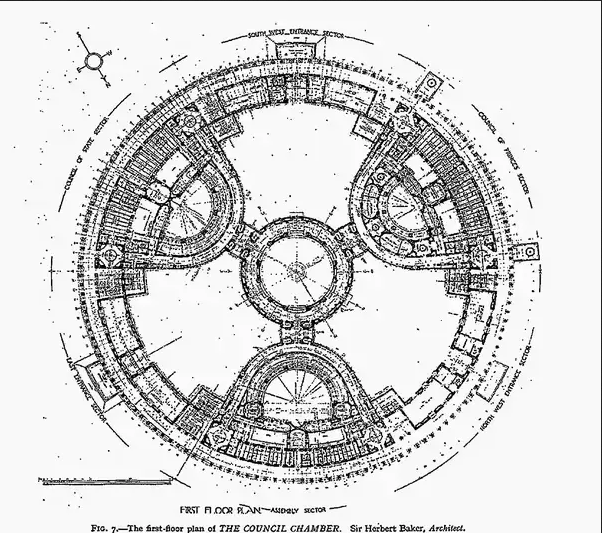
While those critics who are inclined towards number crunching would quite rightly point out that the space allocated per parliamentarian at 1,758 square feet (for the expanded house of 1224 members) is amongst the highest in the world and of course this can be benchmarked against time and usage patterns to establish a cost benefit analysis for the project, I would like to dwell on the oedipien relationship between the existing Parliament and its new counterpart before looking at the relationship it establishes with its neighbours.
Sigmund Freud in describing the psychosexual development of a young boy propounded a theory wherein a boy develops an unconscious sexual (pleasurable) desire for his mother and hence his father who is the object of his mother’s affection is seen with both jealousy and envy. To cope with the associated anxiety, the son internalizes the attitudes, characteristics, and values of the father. The father thus becomes a role model and subsequently the boys’ desire for his mother gets substituted with by a desire for other women.25
Admittedly, such an analogy between buildings and a country is not common but there is through the developmental drawings of the elevations and plans of the proposed Parliament building (the young boy) a desire to appropriate and ultimately share the same affection that the current Parliament building (the father) has with the country (the mother). The high plinth, the colonnade, the choice of materials in the elevations all point towards the internalizing the attitudes characteristics and values of the original Parliament building. In fact, this internalization of the older building is further evident in the spatial strategy of the new plan where offices on the perimeter, three large halls in a triangular formation (the Lok Sabha, the Rajya Sabha and the central hall in the older building and the Lok Sabha, Rajya Sabha and Central Lounge in the proposed building) and a large hall (Central Hall, Constitution Hall) in the middle of them all point towards more similarities than differences.
The oedepian attitude of seeking legitimacy through the valorising of the past only to subsequently deny its continued legitimacy by replacing it is an act of historic treason.
In time the new building will take on an autonomy of its own and will capture the imagination of a collective public. In doing so, it would have robbed the existing Parliament of its raison detre, embalmed through a subsequent upgradation / conservation project for subsequent generations to view as a curiosity. In the “symbol and temple of our democracy” no longer would be embedded a continuity of the democratic project but rather a declaration that, “the old order changeth yielding place to anew…”.
One can comment on the Palace of Westminister that has served the British parliament since 1512 in spite of numerous fires and renovations, or Germany’s Reichstag which was built in 1894, severely damaged by fire in 1933, bombed during the world wars, and then renovated extensively in the 1990’s to form the present seat of the German government as being technologically enabled buildings of historical continuity, and yet we need to recognize that architecture is the construction of an argument, the expression of a point of view that either through representation or through material form serves as punctuation marks on an ever developing cultural landscape. Through the choices we make, we comment on ourselves, our understanding of our world and whether we stand on firm ground or have shaky foundations.
The oedepian attitude of seeking legitimacy through the valorising of the past only to subsequently deny its continued legitimacy by replacing it is an act of historic treason. The conservation project as architectures conscience keeper and middle ground is not anti-development but like a trampoline it is the vehicle that both cushions the fall only to propel one higher and further.
From within such a context, the interlinking of the buildings of the parliamentary complex (the existing Parliament, the Parliament Library building and the Parliaments annexe) or the enclosing with glass the three courtyards of the existing parliament (as was done in the renovation of the British museum, the Reicshtag and also in the library for the Indian Parliament), or renovating the existing Parliament and constructing afresh only the additional area that is needed reflect a modus operandi that seeks to recognize and leverage what currently exists. By creating mutual interdependencies not only does one build on the embedded resilience of the time tested structures but also unlocks their otherwise underused potential that collectively act like a trampoline.
In fact with little in the public domain about the proposed buildings and those that currently exist, one can only speculate based on whatever little information is available what their fate might be.
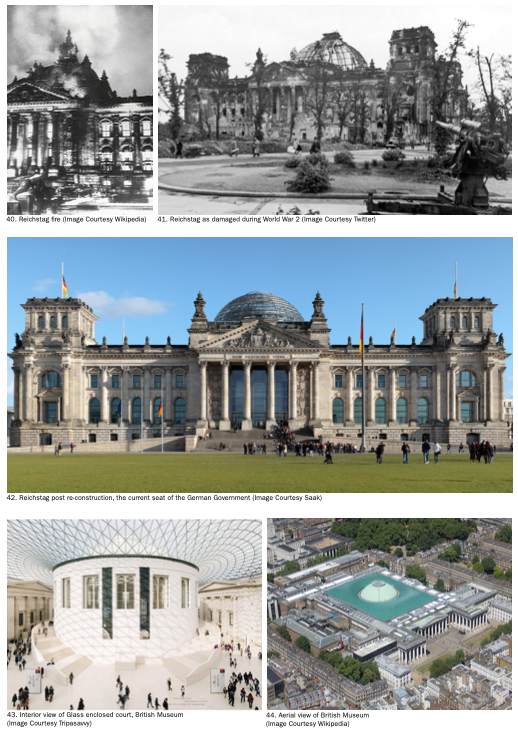
North and South block for example are slated to become national museums. Their conversion into national museums point not only to the robustness of the buildings to be able to sustain such reconstruction (museums are technologically advanced spaces) but also point towards I.M. Pei and François Mitterrand’s renovation of the Louvre in Paris and the ouster of the Finance ministry from it.
(However, before converting the current buildings into National Museums one should through spatial analysis and audit ascertain if the current buildings can be renovated and if need be expanded (subterraneously if needed as the Louvre was). Do we really need to make a new? Can we afford to make a decision involving large amounts of public money without adequately ascertaining the need for it?)
Originally constructed in the twelfth and thirteenth centuries the Louvre has survived fires, war and innumerable renovation projects. As one of the most visited museums in the world, it is today recognizable through Pei’s glass pyramid which illuminates a subterraneous world that orders and connects the museums buildings.
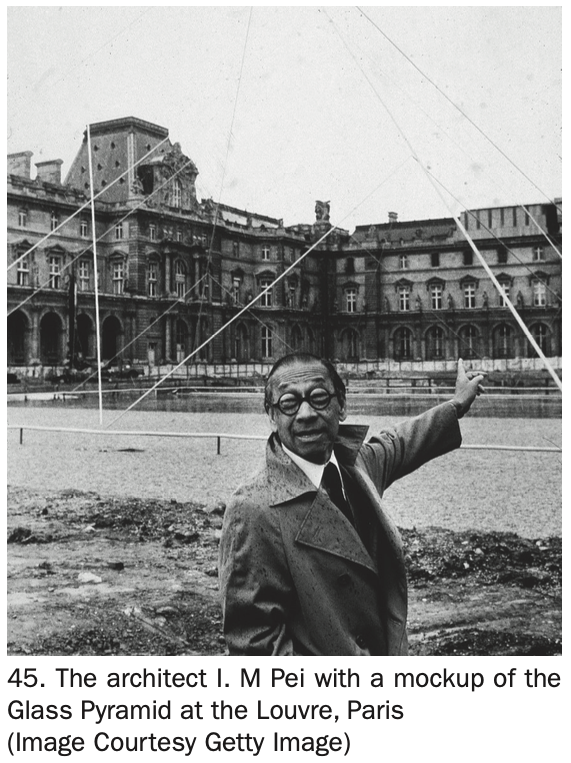
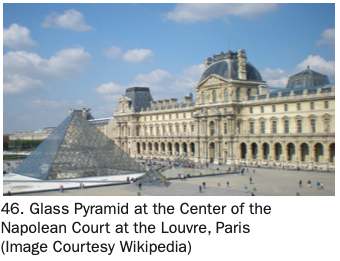
The Baker buildings’ (the current Parliament building) potency within the ensemble of buildings at the central vista is because it is androgynous – as a circular building it has neither the orientation nor the axiality evident in the Lutyens urban plan or in the key buildings that populate it.
The conversion of North and South block into a national museum like the Louvre is a mammoth project. A great part of its success would lie in manner through which the two buildings are integrated and the ease with which people from across the city can visit it. While it would seem advisable that the proposed under ground rail interlinking the ten office buildings be extended to include stops at the Parliament and the national museums such a move would be based on the premise that public accessibility to the spaces and symbols of democracy is a fundamental right. Restricted or hindered access would only undermine the role such institutions play in the making of a civic nationalism.
The Baker buildings (the current Parliament building) potency within the ensemble of buildings at the central vista is because it is androgynous – as a circular building it has neither the orientation nor the axiality evident in the Lutyens urban plan or in the key buildings that populate it. Yet, it shares recognizable features such as the high plinth, the colonnade, the use of sandstone with the other buildings in the vicinity. This distinction is particularly important for the “temple of democracy”, a building that belongs to everyone and also to no one in particular. Likewise, through its symbolism it has to represent the plurality of the country and not the voice of majoritarianism.
It was Herbert Baker who originally had proposed a triangular building for the Parliament on its current site but on Lutyens insistence had to modify it to its present circular form. Baker felt that given the hexagonal layout of the greater New Delhi plan, a triangle would sit more comfortably on the site. Bimal Patel’s triangular building plan refers to the triangle as having a symbolic resonance across multiple faiths. Along with the abstraction of the national flower (the lotus), the national bird (the peacock) it seeks to embed through such iconography the building into cultural consciousness.
The universality of symbols and symbolism in a young and plural country such as India is questionable and perhaps even more so is the decision to employ wholly such a strategy knowing that it represents some, under-represents others and marginalizes yet others. Equally, so do the same symbols represent different things to different people. The colour white for example is worn at Christian marriages (a happy occasion) and also at Hindu funerals (a sad occasion). Furthermore, just as the national flag is representative of the nation and should be treated with dignity and respect, so too should other symbols of our democracy. To invoke symbolism through the mutation and abstraction of their established forms is equally an act of sacrilege as it is of piety.
Mr. Patel in his presentation refers to the fact that many sacred geometries celebrate “triangles and trinities”. He cites the example of the Sri Yatra, the Brahma, Vishnu, Shiva (trimurti) and the jaali patterns of Humayun’s tomb to support his argument that a building is not only the product of pragmatic compulsions but also that the “building up (of) these stories and narratives is as much a part of making the architecture of this place.” He goes on to explain, “why these funny shaped windows here? Well to reflect India’s diversity in some ways” while simultaneously demonstrating diagrammatically that through the superimposition of three triangles one can develop a basic diagram for the plan of the building. Not to be missed, what was mentioned in passing was that a triangular building would just sit better on a triangular plot of land (a view that Herbert Baker too had of the relationship between building and site).26
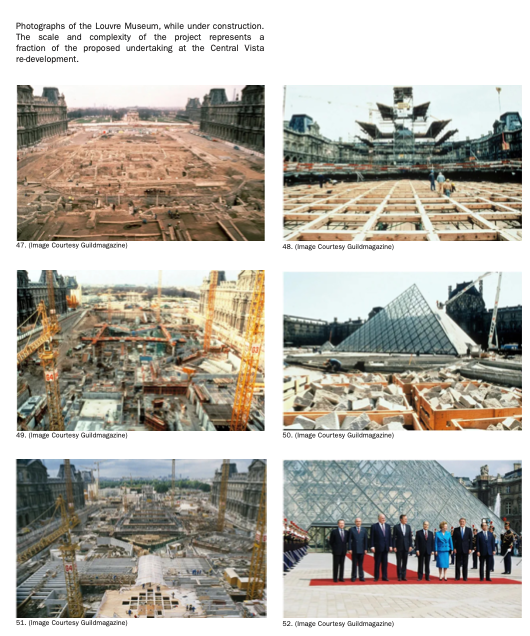
Narratives and stories in architecture are the agents that make an aspect of the work visible. Through the use of analogy, associated imagery, and culturally embedded symbols, these tools make architecture comprehensible and consequently serve as a vehicle in the dissemination of its message. They are tools that make evident an aspect of the design that either sense perceptively or intellectually would otherwise not have been apparent.27 The narrative, contrary to what Mr. Patel proposed of it (“building up (of) these stories and narratives is as much a part of making the architecture of this place.”) is not a tool to give architecture meaning but a tool to make evident aspects of the design that otherwise may otherwise have been lost.
The making of an architectural work approachable to a wider audience and its dissemination to a greater public is what makes the architectural narrative a particularly potent yet uni-dimensional tool. By articulating that the windows represent India’s diversity for example, the architect tells us in no uncertain terms what to think. In doing so he scripts the terms through which we should view the work and thereby pushes other possible interpretations to the margins. Would walls constructed out of the different soil types from within the geographical borders of our country not be equally, if not more comprehensively representative of the diversity of India? Is it a spire or a shikhara that defines the new buildings profile or does the iconographic imagery recall two folded hands in a namaste / sat sri akal formation? Do each of the three segments of the triangular parliament building represent the divine trinity of Brahma, Vishnu and Shiva or of the democratic trinity of the executive, the legislature and the judiciary that defines modern India?
Do each of the three segments of the triangular parliament building represent the divine trinity of Brahma, Vishnu and Shiva or of the democratic trinity of the executive, the legislature and the judiciary that defines modern India?
Architecture, as a discipline of practice has over the centuries developed the tools it needs through which it engages with and represent contemporary culture. Often found in its materiality, its spatial or tectonic expression, the mechanisms of its engagement are intrinsic to the nature of its being. Architecture is first and foremost a spatial art but its volumetric character would not manifest without the materials of its making. Through their articulation and manipulation a culture engages with both craft and industry, people and environment, embedding within it an attitude and value that is part of a greater continuum of cultural production and engagement. Its sets itself both a part of and apart from this greater continuum and in doing so reminds us that architecture communicates in different ways to different people. Not only are strategies, such as narratives that are external to its being, but also ells a person what to think and has to think about the work.
While it is undoubtedly the prerogative of the architect to choose the narratives, the iconographic elements and the design methodology to realize the intent of the project, one cannot divorce an understanding of it from the forms and methods of cultural production of which it is a part. Lutyens and Baker too over a century ago chose to incorporate iconographic elements found in indigenous structures as a means of making their buildings either “Indian” or “more Indian” and in the design of the Parliament, it could be argued took the Chausath Yogini or Claude – Nicolas Ledouxs, project for Hotel Saint-Marceau, as its point of departure. However, and importantly through establishing a continuum with past interpretative models and methods of design, the project does not force a confrontation with the ideas that premised the making of Imperial Delhi but in fact further cements them. The project even though intended to represent India at 75 is not a cultural decolonization and independence project in the way the name “re-imagining and re-envisioning the central vista” suggests nor does it view demographic inclusivity as the cornerstone of the democratic project, and while it engages with culture through trite imagery and narratives that are external to the “being” of architecture, the architecture of the central vista articulate not what India is, nor what India can be but rather what India was and no longer wants to be.
He (Bimal Patel) is in that unique position of establishing both precedent and defining purpose, of scripting a new architectural and urban agenda. Willingly or unwillingly he and his firm are charged with historical purpose. In years to come the central vista project will serve as both precedent and manifesto, this is an opportunity for him, as an architect, an urban planner, an educationalist and a citizen of the country to give form to meaning.
“Architecture more than any other art,” wrote Lutyens to the imperial apologist Valentine Chirol, “ represents the intellectual progress of those in authority.” Lutyens wanted to leave the stamp of British authority on India’s brow. But India has managed to leave its stamp on the brow of the building he built. Rashtrapati Bhawan is a British building but one “built in India for India”. It remains a shining addition to the long line of great buildings in India, some built by born Indians and others by those who came from outside.28
Bimal Patel is an accomplished architect and educator. He currently heads one of the country’s foremost architectural colleges and has a portfolio of work that reflects a deep commitment to the built environment. He is suave and articulate, intelligent and industrious. Mr. Patel and the redevelopment of the central vista would serve as role models not only for generations of architects but also for state and local governments to follow. He is in that unique position of establishing both precedent and defining purpose, of scripting a new architectural and urban agenda. Willingly or unwillingly he and his firm are charged with historical purpose. In years to come the central vista project will serve as both precedent and manifesto, this is an opportunity for him, as an architect, an urban planner, an educationalist and a citizen of the country to give form to meaning.
With the lack of meaningful public consultation and limited information available in the public realm one can through observational and speculative analysis draw inferences on both the design and its process and hope that taken in the spirit of constructive criticism it informs its future development in a positive way. Ultimately, time will tell whether these buildings stand on firm ground or with weak foundations.
Conclusion
(1324 words, 5 minute read)
Some ne’er advance a judgment of their own,
But catch the spreading notion of the town;
They reason and conclude by precedent,
And own stale nonsense which they ne’er invent.
Some judge of authors’ names, not works, and then
Nor praise nor blame the writings, but the men.
Of all this servile herd, the worst is he
Of all this servile herd, the worst is he
That in proud dulness joins with quality,
A constant critic at the great man’s board,
A constant critic at the great man’s board,
To fetch and carry nonsense for my Lord.
What woeful stuff this madrigal would be,
In some starv’d hackney sonneteer, or me?
But let a Lord once own the happy lines,
How the wit brightens! how the style refines!
Before his sacred name flies every fault,
And each exalted stanza teems with thought!29
As architects we communicate through the representations of our buildings and engage through processes that enable their being. The central vista redevelopment plan as a public project is not just a metrically driven quantifiable object but equally a testament to a larger public process.
“Have we lost our vista?”, the title of this essay is a comment on both the process and the manifestation of what is arguably Modern India’s most symbolic architectural and urban design project. While still very much a work in progress, the project presents a fertile ground through which we can demonstrate to a nation at large not only how we view our past but also how we imagine our future. And yet without a parliamentary debate to ascertain its need or the facets of our democracy that it should represent the project in its current incarnation, especially because of the lack of publicly available information appears to be the result of knee jerk incremental decision making.
Both Mr. Patel and his firm HCP Designs are not new to working in the public realm. They understand the communicative potential of architecture and the importance of communicating the intent and design details of a project to a wider constituency. Towards this end and given the use of digital mediums such as “youtube” to broadcast their project presentations, it is surprising that a website has not been established to host updated project information and answer queries that the general public may have.
As architects we communicate through the representations of our buildings and engage through processes that enable their being. The central vista redevelopment plan as a public project is not just a metrically driven quantifiable object but equally a testament to a larger public process. Through the circumvention of both process and public engagement the project is a manifestation of and accountable to the fancies of a select and empowered few.
Participatory engagement also implies engaging with a body of cross disciplinary knowledge and committing to building and contributing to it. Architectural production exists within the greater cauldron of cultural production, where the continued affirmation and repetition of the past only serves to cement historical narratives and prejudices while denying an opportunity to the future.
The creation of a civic space as an instrument of the democratic project does not have to have a mutually exclusionary relationship with the stated intent of creating a vehicle for greater administrative efficiency. In fact, should the two share a symbiotic relationship, it would have a far greater political, social and administrative impact. However, since Independence the nature of the central vista has changed irrevocably and it now exists at the confluence of both a “civic rationalism” and a “civic empiricism”, which through its appropriation by a diverse public demonstrates a propensity towards a social democracy.30
To be appointed as the architect of the central vista redevelopment plan and be charged with the project of giving material and symbolic form to ideas that define the worlds’ largest (and arguably noisiest) democracy would be both a daunting and potentially crippling task. Had Mr. Patel found himself in this position after an open and rigorous selection process he could take solace and draw confidence from having stood the test of fire.
Close to seventy five years having elapsed since India got Independence, time enough for a country to develop a voice characterized by its own diversity – a voice whose articulation through both process and manifestation is a choice held by those in positions of power and influence. Participatory engagement is not a euphemism for catering to the lowest common denominator or the adoption of processes that absolve one of professional responsibility. It does however, imply that passive engagement such as the dissemination of information into the public realm, along with active engagement through dialogues with stake holders and domain experts to lay the ground and establish both context and intention for the project.
And yet, it is equally important to know the defining limits and boundaries of architecture and urbanism as both a field of practice and a discipline of inquiry. As a metier defined by the embodiment of societal value in spatial,material and tectonic terms, architecture lacks the cultural autonomy associated with other arts such as music, painting, poetry or sculpture. Its raison d’etre is inextricably linked to its role as a vehicle to enable particular aspects of the practice of living.
The buildings of the central vista are informed both by the modernist principle of functionalism and by the recent adoption of more generic and flexible spatial and building typologies. For example, the construction of identical blocks for the secretariat could be understood equally as the expression of repetitive banality or the manifestation of future proofed, generic and flexible spaces. Contrary to this is the strategy adopted for the proposed Parliament building where an in depth study and analysis of other similar parliamentary halls have established a typological continuity, something that can be found in the development and consequent treatment of its elevations as well.
Participatory engagement also implies engaging with a body of cross disciplinary knowledge and committing to building and contributing to it. Architectural production exists within the greater cauldron of cultural production, where the continued affirmation and repetition of the past only serves to cement historical narratives and prejudices while denying an opportunity to the future.
Mr. Patel’s understanding and willingness to use history as a catalyst for projecting his buildings into the future is amply evident. Equally evident is the use of different and multiple design strategies to juggle the scale and complexity of such a project. And yet, it is equally important to know the defining limits and boundaries of architecture and urbanism as both a field of practice and a discipline of inquiry. As metier defined by the embodiment of societal value in spatial, material and tectonic terms, architecture lacks the cultural autonomy associated with other arts such as music, painting, poetry or sculpture. Its raison d’etre is inextricably linked to its role as a vehicle to enable particular aspects of the practice of living.
Architecture as a “crafted object” or a receptacle wherein both the decorative and the plastic arts reside has with industrialization and the mass production of architectural components and material ceded space to that of the assembled object. The efficiencies associated with capitalist production and consumption as evidenced in the assembled object are those that would be needed to deliver the buildings of the central vista project in its stipulated time frame. Additionally, as a project whose meaning is going to be defined through the narratives that it transmits in both digital and non digital formats (rather than through unhindered public access to it), the “site” of its architecture would reside not in its material being but in the medium of its transmission. The permanence of architectures’ materiality thus lies no longer in its phenomena nor in its engagement with a context but in its representation and transmission. As an experience devoid of a sensorial or tectonic engagement that has otherwise historically defined architectural consumption, the publicness of the project and its experience is scripted through the ephemerality of digital space and yet, in spite of the ease of transmission of project data, it is ironic that so little is publicly known about India’s most potent public space!
In time, architectural and urban historians will look back at the work of Mr. Patel, his firm HCP designs and their associates and situate its buildings and narratives within the greater imperatives that define our age and will cast comment on it. Until then, I wish his team and him well and hope that in the coming months and years the designs mature and incorporate suggestions to whatever extent possible to make this a project all of India can be proud of!
Epilogue : Democracy, Participation and Consultation
(3238 words, 13 minute read)
“Democracy, Participation and Consultation in conversation with Bimal Patel” a text published in issue 61 of the Journal of Landscape Architecture is autobiographical in both its tone and tenor. Structured around the eight points of his education at Berkley, practicing as an architect / urban planner in the public realm, the relationship between client and professional, Indian versus Western systems, conservation, heritage and the protection of the environment, the selection process of an architect, the design process and finally from where the title of this conclusion is borrowed Democracy, Participation and Consultation, the text with the absence of an interviewer is more monologue than conversation.
Mr. Patel is both lucid and erudite in his arguments and writes in equal measure with both purpose and pace. Articulating both his experience and views on various aspects of the profession from within the context of the central vista redevelopment project, Mr. Patel attributes his early interest in social and development work to Fr. Erviti, a Jesuit priest at his high school who encouraged students to be “reflective development – practitioners” and his preparation for a career in architecture to CEPT his alma mater where he is now the Chairman. University of California, Berkley from where he received his doctrate for equipping him with the “concepts and analytical tools that helped me (Patel) in forming a clear understanding of the world within which I could situate my practice as an architect and urbanist.”
Evident through the professed rationality (the victory of common sense) of both the Delhi project and the text is its existence within the greater crucible of societal transformations that are occurring in India, and the formation of a new global order that oscillates between the disjunction of place and purpose on the one hand, and the convergence of home and work space on the other. Just as in a digital world physical proximity is no longer a prerequisite for administrative efficiency, the onset of the recent corona pandemic has demonstrated that the idea of “home” as a secure live – work construct has replaced the idea of the jet setting global citizen as part of a global urban condition. Consequently, traditional architectural and urban design discourses based on concepts such as rationalism, the zeitgeist or the idea of and faith in development as an agent of positivity are perhaps in adequate in providing context to the questions facing the disciplines of architecture and urbanism.33 The completing of the Lutyens plan as Mr. Patel repeatedly refers to the project only serves to reaffirm the colonial project and is an act of cultural violence that must be met with intellectual resistance.
Furthermore, by adopting a modus operandi that uses the triumph of common sense and rationality as its raison detre, Mr. Patel in essence takes away the theoretical underpinnings of the discipline of architecture, only to give to the profession of architecture a legitimacy arising from the conformity to what is considered prevailing common sense.
The completing of the Lutyens plan as Mr. Patel repeatedly refers to the project only serves to reaffirm the colonial project and is an act of cultural violence that must be met with intellectual resistance.
In doing so we appeal not only to the lowest common denominator but stand to risk making a project whose ideas are dated even before it is completed. The mediocrity associated with such an approach is plain to see in the state of our buildings and cities, however, what is more worrying is the pervasiveness and the democratisation of this as a process both in architecture schools and in professional practice. The systematic erasure of architecture’s agency by the “triumph of common sense” has resulted not in the “construction of arguments” that build on the cultural capital of a civilization but rather reduces the architectural project to a quantifiable commodity where metrics matter more than social agency, engagement and empowerment.
Mr. Patel recognizes this and while his reference to, “the point of constructive engagement is to find areas of agreement and to slowly expand them, through respectful collaboration and mutual learning”34 refers to a relationship with clients, which in the case of the central vista project is the Government of India and by extension through parliamentary process the people of India, the current project neither represents democracy, nor is it particularly participatory in its public outreach and consultation.
Governments exist to uphold and enact the principles of the constitution through the everyday acts of administrating the country. The constitution is the text that supposedly gives meaning and direction to government and governmental processes. Elected governments are caretakers of the constitution and hold it in trust for successive governments and generations. In the case of projects that reflect its functioning, the client is not the government of the day, nor is it the people of India, both of whom are transient actors In the greater continuum of a nations being, but rather it is the ideas and the ideals embodied in the constitution of India, that document which gives the country definition and purpose. After all, if parliament is the temple of democracy then the constitution must be its’ holy scripture. This is what makes the central vista project so unique is not only that it is located on such a potent plot of land but that the “client” are a set of ideas and ideals as documented in the constitution.
by adopting a modus operandi that uses the triumph of common sense and rationality as its raison detre, Mr. Patel in essence takes away the theoretical underpinnings of the discipline of architecture, only to give to the profession of architecture a legitimacy arising from the conformity to what is considered prevailing common sense.
Democracy, Participation and Consultation as a title for the article is misleading. It is the heading of the last of the eight points Mr. Patel makes and alludes to a public participatory process in the design of the project. He states,
“However, it is not practically possible to take all decisions through popular votes, and often, the issues to be decided upon are complex, and require deep expertise to understand and decide upon. As a consequence, some people have to be authorised to take decision for the collective. In a democracy, these decision makers are popularly elected for pre-defined periods of time. Once elected, they expected to apply their minds and take decisions, not to continually go back to the people. In area where deep subject expertise is required for making sound decisions, they are expected to consult experts. In areas where popular inputs can enrich decision making process, they are expected to undertake public consultations – not to turn over the decision making to the public. In addition to this, democracies also allow for a free press, so that public opinion can be made known to decision makers, regardless of whether they consult the public or not.”35
With neither a parliamentary debate on the project, nor any publications in professional journals or public speaking engagements by the architect and his panel of experts addressing issues raised through the press by other eminent experts and professionals or the establishment of a website that would apprise the public of project developments, Mr. Patel’s comments seemed designed more to justify inaction or little action than as the title of the piece suggests participation and consultation in a democracy. Likewise, it would be naïve to say that in public projects especially of this scale that all “activist professionals” are indeed acting out of a genuine concern for the project. There are both professional jealousies as well as political alliances whose motivation is not “constructive engagement” but rather to derail the project. However, one cannot assume that every activist professional means harm and engaging with genuine critical feedback is a professional responsibility.
In the same vein not following the processes and procedures of democracy would also only serve to weaken and undermine it.
What makes the central vista project so unique is not only that it is located on such a potent plot of land but that the “client” are a set of ideas and ideals as documented in the constitution.
A. Practice in the Public Realm
“But even those who were, had gradually lost their voice in public affairs, largely because they had lost touch with the political class, which, with the deepening of democracy was no longer formed from the traditional elites of the post -independence era. Even today, we professionals claim to like the concept of democracy, but when democracy does its job of putting people in power who think differently from us and different priorities, we complain that we can’t work with them.”36
“The point of constructive engagement is to find areas of agreement and to slowly expand them, through respectful collaboration and mutual learning.”37
The “deepening of democracy” is not an act of either alienating or marginalizing “traditional elites” but of strengthening the institutions that enable democracy to be both more equitable and encompassing across demographic groups. The question is not whether the processes of democracy puts in place people with whom one agrees with or disagrees with, people with whom one can work or not, but whether the process allows for the multiplicity of voices to be heard and considered. To work in the public realm is to work for a faceless client.
The central vista and its immediate precinct is the symbolic centre of our democracy. Working to strengthen it through both an architectural and an urban design project would as its premise have to recognize that the client is not the government (who are transient caretakers of the country’s administration) but a set of democratic ideals as articulated in the constitution. In this respect the central vista redevelopment project is distinctly different from other public projects such as the redevelopment of a street, the Sabarmati river waterfront or the Kashi Vishawanth Dham that HCP Designs have completed. The project is articulated in as much through the processes it follows as by its ultimate spatial and material manifestation. To work in the public realm does not only necessitate a willingness to “constructively engage” with politicians, bureaucrats, municipalities etc. only, but also with the public and its representatives! Failure to do so, or to do so in a limiting format is to authoritatively impose a limited imagination on the public realm while distancing the “public” from the processes that would define it. Ironically, this would through the establishment of precedent weaken the workings of democracy.
To practice of architecture and urban design / planning is to practice in the public realm. These are disciplines that simultaneously engage with climate and environment, with local communities and with local and global economies. The decisions made by an architect, urban designer, a politician or a bureaucrat and others in a similar position have a direct impact on the livelihoods of people and communities and of the environment(s) and habitats they construct for the present and for future generations.
The project is articulated in as much through the processes it follows as by its ultimate spatial and material manifestation.
B. The Client – Professional Relationship
“I prefer a relationship that acknowledges mutual dependence, which is based on trust and mutual respect. That is not to say that it is a relationship between equals. The project belongs to the client. For the architect to be successful he must a sense of ownership for the project but he cannot presume to own it. As in the case of the doctor-patient relationship, whether to finally heed the advice of the professional or not is the client’s prerogative.”38
The nature of a client – professional relationship is largely a function of the type of project one is working on. For example, an architect working on a small residence would work very closely with both those who commission the work as well as those who will ultimately live in the house. In other projects there are “caretaker clients” represented through committees and for a specific duration of time. These clients through an act of trust look after and nurture the project till such time they are replaced. And, while during their tenure it is their prerogative to make and recommend certain decisions, the defining authority or the “client” are not “the caretakers” but the adherence to the processes that empower their being and enable through the allocation of public resources their making. When early on in his career the head of the Urban Development Authority told Mr. Patel that he was only the “suggesting authority” not the “deciding authority”, he failed to realize that while working in the public realm they are both “public servants” who work at the behest of other people.
Irrespective of whether one is working on a private or a public commission in a work of architecture converge not only multiple imaginations but also skill sets that collectively through a process of co-dependencies result in the built work. Not only is there a multiplicity of authors other than just a client – professional but also through the act of inhabitation the work is appropriated and in time takes on both new meanings and form.
C. Indian Versus Western
“When we see something that works we adopt it. When we have to design cities where millions of people have to live in close proximity, we should not hesitate in adopting suitable solutions that have worked elsewhere. Fortunately for us, many societies have faced the same urban problems that we are facing today, and come up with very good solutions. We should adopt those solutions. We should not insist on reinventing the wheel.”39
In a world of mutliplicities, the setting up, even for discussion a binary such as Indian versus Western is of little relevance and consequence. Of course one should look for, adopt and adapt methods and processes that would help improve the quality of our lives but equally, when working from within an environment of such diversity it is the ambivalences, hybridities and thirdspaces that exist through negotiated encounters that give our urbanism its episodic character. In recognition of this, it is important to note that different Indias’ face different urban problems and prioritize them differently, and while through their definition one exercises authoritarian autonomy, the setting up of infrastructures to empower and enable people to exercise individual choice equally devolves the professional of a certain degree of responsibility. The construction of a humanist argument manifested not through the marginalizing polarities that binaries create would only serve to further the democratic project of self governance and definition.
but equally, when working from within an environment of such diversity it is the ambivalences, hybridities and thirdspaces that exist through negotiated encounters that give our urbanism its episodic character.
D. Conserving Heritage and Protecting the Environment
“Today people have become far more apprehensive and intolerant of change, regardless of how necessary it is. Discussions about heritage conservation are extreme and highly politicised. The design for the Central Vista Project respects all the magnificent Lutyens and Baker buildings. It also respects the structure of the street layout and the layout of the landscape. Regardless of this, some people claim that the design is destroying the heritage. Perhaps they have not been able to examine the plans and appraise themselves of the facts.”40
“When considering the reordering of the landscape, so far as the benefits to be gained promise to be more than costs and so far as we are also taking compensatory steps – planting more trees – to mitigate the costs that the reordering of the landscape entails, we should not stop ourselves from making the change. Unfortunately, we seem to have forgotten how to think of making trade-offs. When it comes to discussing the environmental impact of a project, we only want to look at the cost side of the equation and refuse to engage in further discussion.”41
New Delhi’s central vista is neither the confluence nor the juxtaposition of individual elements of an urban, landscape or architectural plan but through their collective a greater ensemble. Importantly, this ensemble is situated within the greater continuum of cultural production and the development of the individual design disciplines that contribute towards the making of it. A project such as this is equally a comment on how we see our present in relation to our past and our future both in disciplinary terms as well as in cultural terms.
Architectural pluralism and stylistic diversity can be viewed as a form of resistance to the affirmation of a colonial order. And, while in the guise of respecting historical precedent and tradition the project as its modus operandi picks up historical traces (specifically the architectural elements and strategies of the older buildings and their incorporation into newer structures such as the proposed Parliament) respects “the structure of the street and the layout of the landscape” and conserves key buildings ( such as North and South Block, the National Archive). As a strategy to intervene in such a potent site through the identification of the precincts “dna” and establishing strands of continuity and change may outwardly be a reasonable response to addressing the problems raised by individual elements of the ensemble. However, the stated need for greater administrative efficiency as being one of the projects primary purposes is a manifestation of the question that is embedded in the heritage argument – through the various landscapes that occupy and define the central vista how do you reconcile two opposing political and economic systems, that of colonial India and that of post colonial India into a democratic whole?
Heritage and conservation are not apprehensive or intolerant of change. In fact, without change and development there would be no future heritage nor anything to conserve. Conservation is architectures conscience, it is architectures middle ground which in a garden city like Delhi lies within both a structured and natural landscape. A cost – benefit analysis of trade offs in as complex an ensemble as New Delhi is to approach the project in a piece meal manner which when coupled with the lack of adequate preparatory research may have unintended and irrevocable consequences.
E. Selecting Architects through Competitions
“When setting up a competition to select an architect, one must be very clear about whether the project that one is selecting an for allows one to select “an appropriate design” or demands the selection of “an appropriate architect”. For extremely complex projects, it would be foolish to select an architect primarily on the basis of a quick concept developed by the architect. One has to judge the capacity of the architect to undertake the arduous task of the whole design process and to deliver on the final design…to select one who has the capacity to deliver on the final product., not just a persuasive first conceptual sketch.”
This is a paradoxical statement. Choosing an appropriate design (this could be based on more than just a quick concept) does come with the risk of appointing someone who cannot deliver on such a large and complex project. Likewise, choosing an appropriate architect is fraught with the risk of choosing a banal design and putting all your eggs in one basket!
The reason why multi-stage competitions are held and subsequently bids submitted by teams of contractors and architects is to reduce risk and to ensure that the best possible design can be realized with the least risk and the greatest efficiency. Given both the public nature of the project, its symbolic value and the legacy it is going to leave for future generations of Indians, it would seem that we should first get an “appropriate design” and then an “appropriate” team to deliver on it.
Bibliography
https://www.youtube.com/watch?v=BXbvc3oLIBk&feature=youtu.be https://www youtube.com/watch?v=vX3d5RO8H1M
https://www.youtube.com/watch?v=SYjy24i_cnM https://architexturez.net/pst/az-cf-180974-1481470282
https://timesofindia.indiatimes.com/city/delhi/new-parliament-house-likely-to-cost- rs-776-crore/articleshow/74216560.cms
http://www.rajrewal.in/projects/Public-parl-lib.htm
https://www.firstpost.com/politics/narendra-modi-inaugurates-energy-efficient- parliament-house-annexe-extension-building-3878405.html
https://www.simplypsychology.org/oedipal-complex.htmlhttps://www.youtube.com/ watch?v=BXbvc3oLIBk&feature=youtu.be
https://www.youtube.com/watch?v=-aJK8Vkr4N4 https://magaceen.com/en/interview/moneo-frampton/
https://architexturez.net/doc/az-cf-21213#:~:text=We%20have%20looked%20 at%20the,became%20a%20self%2Dconscious%20exercise.
Pope, Alexander, “An Essay on Criticism”, https://www.poetryfoundation.org/ articles/69379/an-essay-on-criticism
Irving, Robert Grant, “Indian Summer, Lutyens Baker and Imperial Delhi, Yale University Press, 1984
Hunt, Tristram, “Ten Cities that made an Empire”, Allen Lane an imprint of Penguin Books
1931.Byron,“New Delhi” in Architectural Review, Vol. LXIX, No. 410, January 1931.
Baker, “New Delhi: The Problem of Style”, Times (London) October 3, 1912. Reprinted idem, Architecture and Personalities, Appendix C.
Prasad Sharada, H.Y. Rashstrapati Bhawan, The Story of the Presidents House, Publications Division of the Ministry of Information in association with the National Institute of Design for Rashtrapati Bhawan, New Delhi 1992.
“Democracy, Participation and Consultation conversation with Bimal Patel”, Journal of Landscape Architecture, Issue 61.
[1] At the time of writing this article the tender forthe construction of the proposed Parliament building had been floated and its award was imminent.
[2] https://www.youtube.com/ watch?v=BXbvc3oLIBk&feature=youtu.be 19.22 minutes
[3] https://www.youtube.com/watch?v=vX3d5RO8H1M 4:45minutes
[4] Pope, Alexander, “An Essay on Criticism”, https://www.poetryfoundation.org articles/69379/anessay-on-criticism
[5] Pope, Alexander, “An Essay on Criticism”, https://www.poetryfoundation.org/ articles/69379/anessay-on-criticism
[6] The term “constructive engagement” is in reference to it as used by Bimal Patel in his interview “Democracy, Participation and Consultation conversation with Bimal Patel”, Journal of Landscape Architecture, issue 61, page 87
[7] Irving, Robert Grant, “Indian Summer, Lutyens Baker and Imperial Delhi, Yale University Press, 1984pg.
[8] Hunt, Tristram,“Ten Cities that made an Empire”, Allen Lane an imprint of Penguin Books, pg. 10
[9] Irving, Robert Grant, “Indian Summer, Lutyens Baker and Imperial Delhi, Yale University Press, 1984pg.
[10] https://www.youtube.com/watch?v=SYjy24i_cnM(Mr. Patel repeatedly uses the words sense /common sense to explain his project as a rational response to a given /defined set of problems that need to be remedied.
[11] Speaking at Agenda Aajtak 2019
[12] Pope, Alexander, “An Essay on Criticism”, https://www.poetryfoundation.org/ articles/69379/anessay-on-criticism
[13] The term “relational peripheries” was proposed by the urban geographer, David Harvey. Bimal Patel’s PhD. Advisor, Prof. Richard Walker was a protégé of Prof. David Harvey.
[14] Interesting to note here is a comparison of the building types that flank the central axisof other capitals of the world,most notably Washington D.C.
[15] Admittedly this would involve the demolition or adaptive re-useof existing structures all of which may not be currently under government ownership.
[16] Pope, Alexander, “An Essay on Criticism”, https://www.poetryfoundation.org/ articles/69379/anessay-on-criticism
[17] Looking at an architect’s oeuvre especially over a career spanning decades one can observe the hands of both a rational revivalistand the interpretive technologist at work often simultaneously in a project.
[18] Baahubali was a 2015 epicmovie directed by S.S. Rajamouli. The film set caught the imagination of the then chief minister of Andhra Pradesh N Chandrababu Naidu who then, “ According to official sources,chief minister N Chandrababu Naidu hit upon the idea of involving Rajamouli in finalising the designs of various buildings in tune with Telugu history and culture during a recent review meeting with the officialsof the AP Capital Region Development Authority (APCRDA).”
https://architexturez.net/pst/az-cf-180974-1481470282
[19] R. B yron, “New Delhi” in Architectural Review, Vol.LXIX, No. 410, January 1931.
[20] Baker, “New Delhi: The Problem of Style”, Times (London) October 3, 1912. Reprintedidem, Architecture and Personalities, Appendix C, pg. 218-22.
[21] https://timesofindia.indiatimes.com/city/delhi/new-parliament-house-likely-to- cost-rs-776-crore/articleshow/74216560.cms
[22] http://www.rajrewal.in/projects/Public-parl-lib.htm
[23] https://www.firstpost.com/politics/narendra-modi-inaugurates-energy-efficient- parliamenthouse- annexe-extension-building-3878405.html
[24] https://www.simplypsychology.org/oedipal-complex.html
[25] https://www.youtube.com/watch?v=BXbvc3oLIB k&feature=youtu.be 38 mins 52 sec.
[26] Tounderstand a work “sense -perceptively” as against to “know” it “intellectually” is akin todescribing the ones distance from an object – the moon is just beyond the trees is equally a description of distance as is the moon is 384,000 km away.
[27] Prasad Sharada, H.Y.Rashstrapati B hawan, The Story of the Presidents House, Publications Division of the Ministry of Information in association with the National Institute of Design for Rashtrapati Bhawan, New Delhi 1992, pg.41
[28] Pope, Alexander, “An Essay on Criticism”, https://www.poetryfoundation.org/ articles/69379/anessay-on-criticism
[29] The term social democracy is intended to be distinct from a socialistunderstanding of democracy. It refersto the usage and appropriation of space by people through the instruments of individualand collective empowerment.
[30] Public accessibility will on account of security concerns will inevitably have to be curtailed.
[31] As an architect B imal Patel and his firm HCP Designs produces the representations of buildings that subsequently
[32] https://www.youtube.com/watch?v=-aJK8Vkr4N4
[33] https://magaceen.com/en/interview/moneo-frampton/
[34] “Democracy, Participation and Consultation conversation with Bimal Patel”, Journal of Landscape Architecture, issue 61, page 87
[35] “Democracy, Participation and Consultation conversation with Bimal Patel”, Journal of Landscape Architecture, issue 61, page 96
[36] “Democracy, Participation and Consultation conversation with Bimal Patel”, Journal of Landscape Architecture, issue 61, page 88
[37] “Democracy, Participation and Consultation conversation with Bimal Patel”, Journal of Landscape Architecture, issue 61, page 88
[38] “Democracy, Participation and Consultation conversation with Bimal Patel”, Journal of Landscape Architecture, issue 61, page 88
[39] “Democracy, Participation and Consultation conversation with Bimal Patel”, Journal of Landscape Architecture, issue 61, page 89
[40] “Democracy, Participation and Consultation conversation with Bimal Patel”, Journal of Landscape Architecture, issue 61, page 90
[41] “Democracy, Participation and Consultation conversation with Bimal Patel”, Journal of Landscape Architecture, issue 61, page 90
[42] “Democracy, Participation and Consultation conversation with Bimal Patel”, Journal of Landscape Architecture, issue 61, page 91
Image Credits
1.Image Courtesy Journal of Landscape Architecture, issue 61
2. https://www.google.com/imgres?imgurl=https%3A%2F%2Fupload. wikimedia.org%2Fwikipedia%2Fcommons%2Fthumb%2F0%2F00%2FCharles_ Hardinge%252C_1st_Baron_Hardinge_of_Penshurst%252C_and_Winifred_ Selina%252C_n%25C3%25A9e_Sturt%252C_Lady_Hardinge_of_Penshurst. jpg%2F250px-Charles_Hardinge%252C_1st_Baron_Hardinge_of_Penshurst%252C_ and_Winifred_Selina%252C_n%25C3%25A9e_Sturt%252C_Lady_Hardinge_of_ Penshurst.jpg&imgrefurl=https%3A%2F%2Fen.wikipedia.org%2Fwiki%2FCharles_ Hardinge%2C_1st_Baron_Hardinge_of_Penshurst&tbnid=gHbrhh_
3. https://commons.wikimedia.org/wiki/File:Delhi_Victory_Week_Parade_IND5042. jpg
4. http://deviant.cyberdeath.org/view_.asp?id=191 5. https://www.bing.com/maps
6. https://www.reddit.com/r/papertowns/comments/h0mm5j/plan_of_the_city_of_ new_delhi_india_1910s_the/
7. https://www.bing.com/maps
8. https://www.youtube.com/watch?v=BXbvc3oLIBk
9. https://www.archdaily.com/789671/ad-classics-palace-of- westminster-houses-of-parliament-london-uk-charles-barry-and-augustus- pugin/57636e3ae58ece0d87000050-ad-classics-palace-of-westminster-houses-of- parliament-london-uk-charles-barry-and-augustus-pugin-image
10. https://www.bing.com/maps
11. https://www.dnaindia.com/india/report-delhi-s-rail-bhavan-to-be-shut-again-after- staffer-tests-positive-for-covid-19-2825949
12. https://www.thestatesman.com/india/delhi-shastri-bhawan-partially-sealed-law- ministry-official-tests-positive-coronavirus-1502884425.html
13. https://mapio.net/pic/p-42433854/
14. https://www.quora.com/How-did-they-manage-to-perfectly-align-the-Axe- Historique-arc-de-triomphe-the-obelisk-the-arc-du-carrousel-etc-monuments-in-Paris
15. https://en.wikipedia.org/wiki/S%C3%A3o_Paulo_Museum_of_Art
16. https://rashtrapatisachivalaya.gov.in/
17. http://ddnews.gov.in/national/both-houses-parliament-adjourned-till-27-dec
18. https://en.wikipedia.org/wiki/Albert_Speer#/media/File:Bundesarchiv_ Bild_146III-373,_Modell_der_Neugestaltung_Berlins_(%22Germania%22).jpg
19. https://web.stanford.edu/dept/german/berlin_class/archives/speer_gallery/ berlinplan1938.html
20. https://www.bing.com/maps
21. https://www.bing.com/maps
22. https://www.bing.com/maps
23. https://www.mintageworld.com/view-product/1736-republic-of-india-125th- anniversary-of-national-archives/#
24. https://banknotecoinstamp.com/product/national-archives-of-india-125-years- commemorative-unc-set/
Off the Cuff : Have We Lost Our Vista? (Interim thoughts on a work in progress) 40
25. https://www.hcp.co.in/project/iim-ahmedabad-new-campus 26. https://www.hcp.co.in/project/iim-ahmedabad-new-campus
27. https://www.iima.ac.in/image/image_gallery540f.jpg?uuid=a245810d- 03bb-451d-98c6-1f448504e7c1&groupId=165249&filename=Final_campus. jpg&t=1481477172414
28. https://www.hcp.co.in/project/iim-ahmedabad-new-campus 29. https://www.youtube.com
30. https://www.hcp.co.in/project/swarnim-sankul
31. https://www.youtube.com
32. https://upload.wikimedia.org/wikipedia/commons/3/33/Louis_Kahn_Plaza.jpg 33. https://www.youtube.com
34. https://www.archdaily.com/882188/2018-world-monuments-watch-lists-50- cultural-sites-at-risk-from-human-and-natural-threats/59ee2eb0b22e3827e2000017- 2018-world-monuments-watch-lists-50-cultural-sites-at-risk-from-human-and-natural- threats-image?next_project=no
35. https://www.youtube.com
36. https://tunza.eco-generation.org/ambassadorReportView.jsp?viewID=12894
37. https://www.hindustantimes.com/delhi-news/parliament-staff-caterers-to-be- consulted-for-new-parliament-complex-plan/story-gmDKQTywicBtP82fe9EY7J.html
38. https://www.youtube.com
39. https://www.bing.com/maps
40. https://en.wikipedia.org/wiki/Reichstag_fire#/media/File:Reichstagsbrand.jpg
41. https://twitter.com/weird_hist/status/836282129742909442/photo/1
42. https://www.saak.nl/battlefield%20tour/2008%20berlin/berlin%20history/ berlin1933/berlin1933%20en.html
43. https://www.tripsavvy.com/treasures-of-the-british-museum-1661292
44. https://en.wikipedia.org/wiki/British_Museum#/media/File:British_Museum_ (aerial).jpg
45. AGIP/Getty ImagesI.M. Pei on the Louvre Pyramid construction site
46. https://en.wikipedia.org/wiki/National_Mall#/media/File:McMillan_Plan.jpg
47 – 52. https://www.guildmagazine.com/art/celebrating-an-architectural-maste piece-the-louvre-pyramid/
HCP Designs’, the Patel Project lies at the intersection of these events – the making of New Delhi as an expression of Imperial will, the post-independence appropriation of it as both the symbol and the seat of self-governance and finally, through the current project, the site of both inscription and erasure, of memory and of a vision. Through its location at such an intersection, the manifestation of the Patel Project will underscore the role that legacy and collective memory play in serving as both impetus and point of departure. As constructed entities they are both intimately linked to the politics of power and the expression of will. In its’ manifestation the project would question the nature of the archive and articulate a position with reference to it – its spatial, material and symbolic narratives would serve as vehicles and agents of either the avant garde or the reaffirmation of the politics and aspirations of the past.
